Wacom Co PTH850 Pen & Touch Tablet User Manual Cobra Intuos Manual FrameMakerV7x
Wacom Co Ltd Pen & Touch Tablet Cobra Intuos Manual FrameMakerV7x
Wacom Co >
Contents
- 1. User manual 1 of 4
- 2. User manual 2 of 4
- 3. User manual 3 of 4
- 4. User manual 4 of 4
User manual 2 of 4
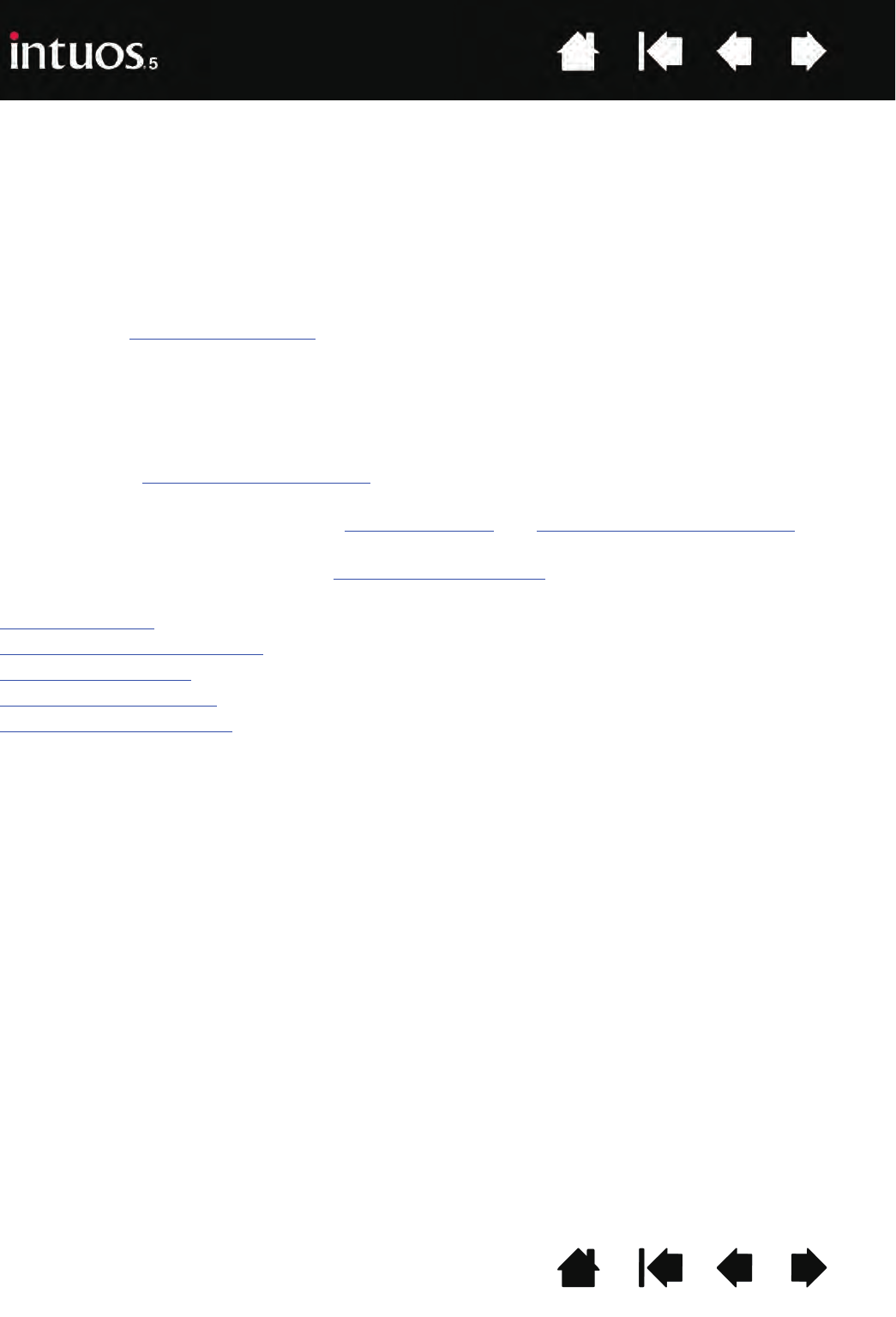
88
88
IndexContents
IndexContents
TROUBLESHOOTING
If you are having trouble, Wacom recommends you do the following:
1. If the tablet driver failed to load properly, first perform the recommended action in any error message
that may appear on your screen. If that does not solve the problem, review the troubleshooting
procedures in this chapter.
2. Look in the troubleshooting tables. Your problem may be described there and you can try the solution
offered.
3. Open the Wacom tablet Read Me file and look for any information updates.
4. Visit www.wacom.com and choose the Wacom web site for your region where you can check the
product FAQs (Frequently Asked Questions).
5. If you are having a compatibility conflict between Intuos and a new hardware or software
product, see obtaining driver downloads for information on downloading an updated software driver.
Wacom periodically updates the software driver to maintain compatibility with new products.
6. Test your tablet and input tools. See te sting y o u r t a b l e t and testing controls and input tools.
7. If you have tried the suggestions in this manual and still cannot resolve the problem, then contact
Wacom for Technical Support. See technical support options and the Read Me file for information on
where to obtain support for your region.
Testing your tablet
Testing controls and input tools
Troubleshooting tables
Technical support options
Obtaining driver downloads
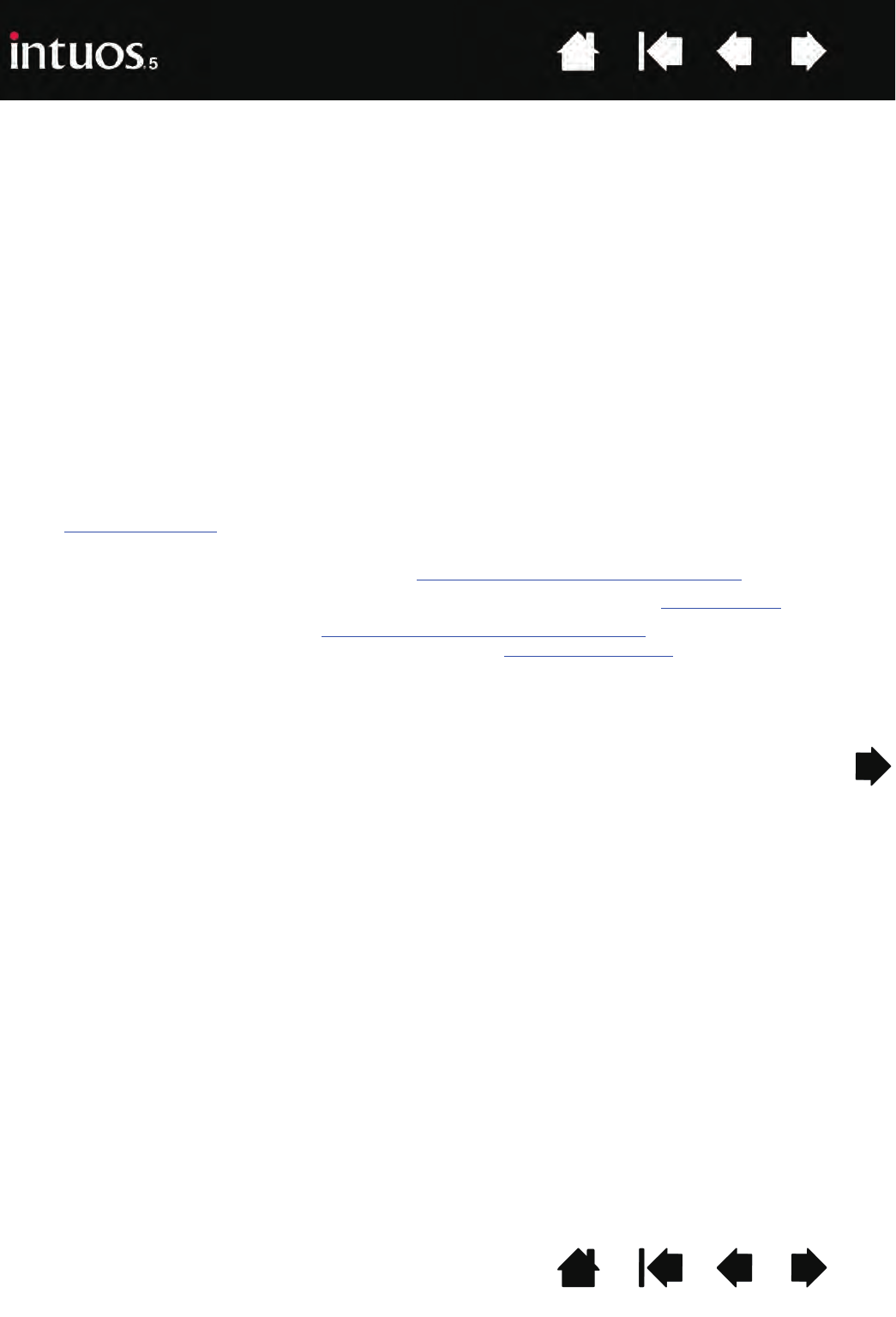
89
IndexContents
89
IndexContents
TESTING YOUR TABLET
1. Turn on your computer and wait until the system has fully loaded.
2. Check the USB connection. A tablet status LED should glow whenever the tablet is properly connected
and your computer has registered it as a USB device. If not:
• Make sure the tablet USB cable is securely connected to an active USB port on your computer.
• Check the tablet USB cable for damage.
• If you are connecting the tablet to a USB hub (or hub device such as a keyboard with USB ports), be
sure the USB hub is properly connected to your computer and is active.
• If a status LED does not illuminate after your computer is on and has finished booting up, your USB
port may be disabled. Verify that you have connected the tablet to an active USB port.
• Connect the tablet to a different USB port or try connecting to the USB port on another computer.
• For best results when troubleshooting no power to the tablet (a status LED does not light), plug the
tablet directly into the system USB port located on your computer. Temporarily eliminate any
external hubs in use until you determine that the system recognizes the tablet and that it is
functional. When the tablet is working properly, it is usually okay to then move the tablet to a USB
hub.
3. For wireless operation, check the tablet connection. A tablet status LED should glow whenever the
tablet is properly connected and your computer has registered it as a USB device. If not:
• Verify that the wireless module is on. See battery and wireless connection status.
• Verify that the wireless module and receiver are properly installed. See wireless setup.
• Check the battery power. See battery and wireless connection status. If the battery charge is low,
connect the USB cable and charge the battery. See charging the battery.
• Switch the wireless module off, and then back on.
• Move the tablet closer to the computer. Make sure there are no metal or other high density
obstructions in the line of sight between the tablet and computer.

90
IndexContents
90
IndexContents
4. Check pen input. If the tablet driver does not load properly, pen input will not be available. (You will be
able to use the pen tip to move the screen cursor and click, but there will be no other pen functionality.)
Install the tablet driver software.
• Move your pen across the tablet active area. The screen cursor should move in the corresponding
direction on your monitor or display screen.
• Press the pen tip against the surface of the tablet. A status LED should brighten.
• Next, without applying pressure to the pen tip, hold the pen tip within approximately 10 mm
(0.4 inch) of the tablet surface and press the side switch. The LED should again brighten.
• Turn the pen over and press the eraser against the surface of the tablet. The LED should brighten.
See also testing controls and input tools and te st i n g a pe n .
5. Check touch input. Attempt to move the screen cursor by tracking your finger across the tablet
surface. Then tap to select an item. The status LED should brighten when you touch the active area of
the tablet. See also te s t i n g t o u c h .
If the tablet driver does not load properly, basic touch movement will be recognized but other actions
and gestures will not. If gestures are not recognized, install the tablet driver software.
6. Check the ExpressKeys. See testing controls and input tools and testing the ExpressKeys.
7. Check the Touch Ring. See testing controls and input tools and testing the Touch Ring.
8. Check any other tool(s), such as the optional Intuos Mouse. See testing controls and input tools.
If any of these tests fail, you may have defective hardware. See technical support options.
After testing, use the Wacom Tablet control panel to reconfigure your tablet and tools for any custom
settings you may originally have been using.
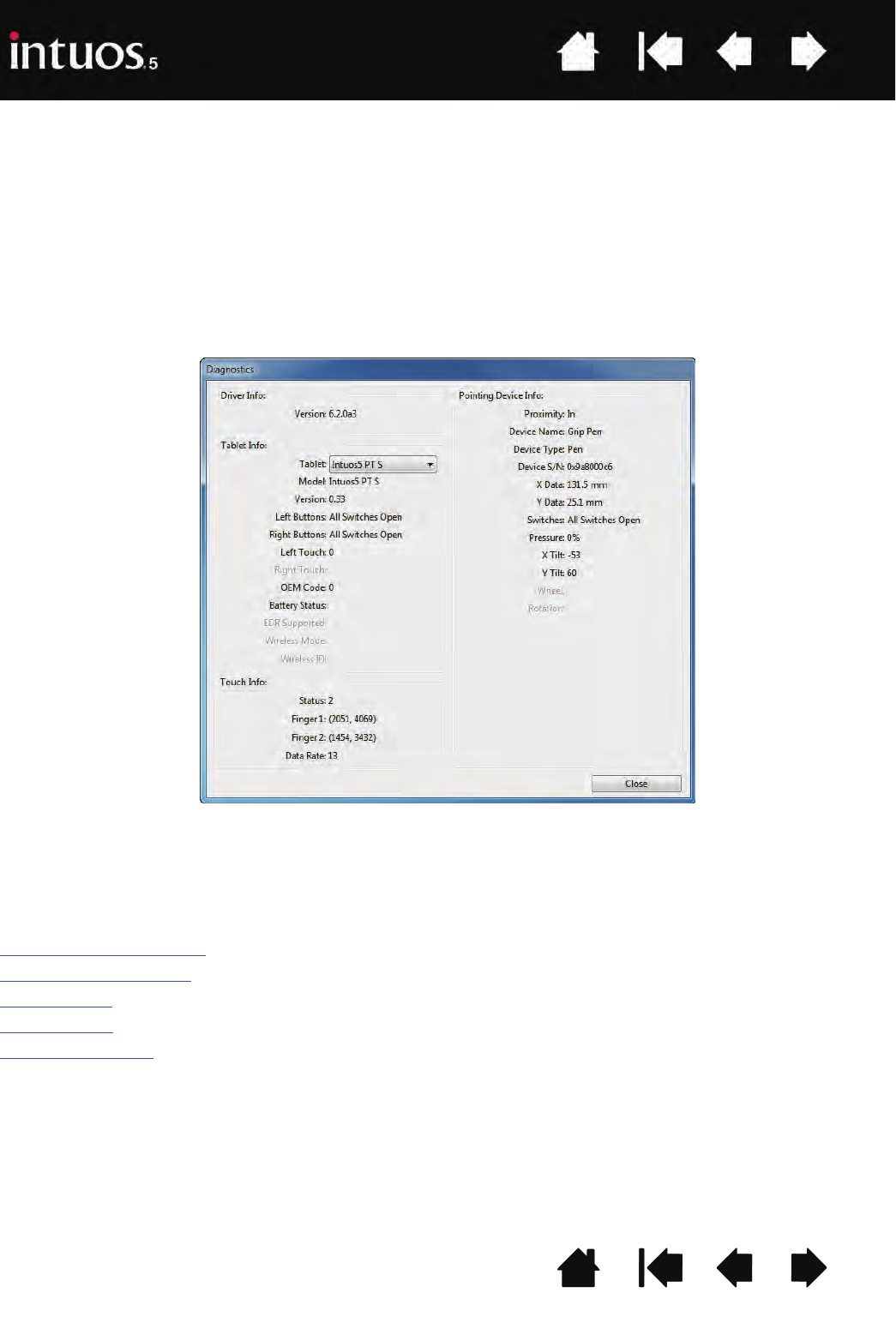
91
IndexContents
91
IndexContents
TESTING CONTROLS AND INPUT TOOLS
If your input tools or tablet controls do not work as you expect, it is a good idea to first check the assigned
functions or reset them to their default conditions. You will also want to do this if you have a touch-
sensitive tablet model and encounter problems with touch.
A quick way to return a tool to its default condition is to remove it from the control panel T
OOL list. Do this
by selecting the tool and clicking on the TOOL list [ – ] button. After the tool has been removed, place it
back onto the tablet surface. The tool will be added back to the TOOL list with its default settings.
• Open the Wacom Tablet control panel and click on the ABOUT button. In the dialog box that appears,
click DIAGNOSE.... The DIAGNOSTICS dialog box shows dynamic information about the tablet, your input
tool(s), and appropriate information for touch-sensitive tablets.
• If more than one tablet is connected to your system, in the TABLET INFO column select the unit for which
you are testing.
• Use the information shown in the DIAGNOSTICS dialog box when testing your tablet and input tools.
Note: If a tool button is set to RADIAL MENU or OPEN/RUN..., that function will occur when the button is
pressed. In this case you may want to change the button function before testing.
Testing the ExpressKeys
Tes ti n g th e Tou c h R i ng
Tes ti n g a pe n
Tes ti n g t o uc h
Tes ti n g t h e m o u s e
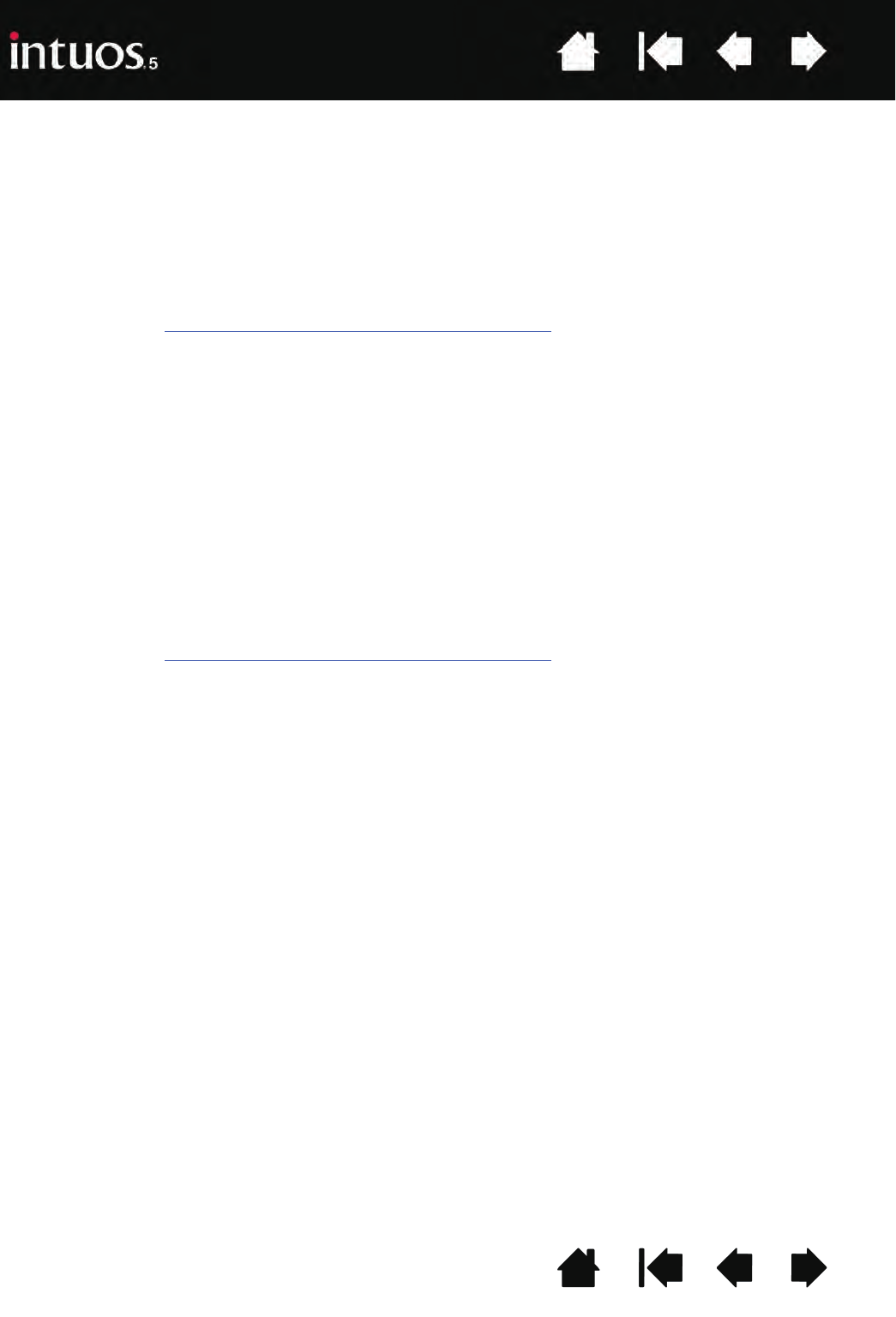
92
IndexContents
92
IndexContents
TESTING THE EXPRESSKEYS
1. With the DIAGNOSTICS dialog box open, observe the TABLET INFO column as you test each ExpressKey.
Be sure to select the tablet unit you are testing from the TABLET INFO column.
2. Test the keys by pressing them one at a time. Each time you press a key, its number is shown next to
the LEFT BUTTONS category.
3. When you are done, click the CLOSE button to exit the dialog box.
Important: Some applications can override and control the ExpressKey functions. Consider closing
any open applications except the Wacom Tablet control panel when testing the ExpressKeys.
For details, see using applications integrated for tablet control.
TESTING THE TOUCH RING
1. With the DIAGNOSTICS dialog box open, observe the TABLET INFO column as you test the Touch Ring.
Be sure to select the tablet unit you are testing from the TABLET INFO column.
2. Slide your finger around the entire circumference of the Touch Ring. As you touch and move your finger
along the Touch Ring, a LEFT TOUCH number will indicate your current finger position on the Touch Ring
3. Press the Touch Ring toggle button to toggle between the four customizable modes. As you cycle
between settings, a corresponding LED should illuminate. Within the DIAGNOSTICS dialog box, the
button mode is also shown as LEFT BUTTONS.
If any of the functions are set to SKIP, the corresponding LED will be skipped in the toggle sequence.
4. When you are done, click on the CLOSE button to exit the dialog box.
Important: Some applications can override and control the Touch Ring functions. Consider closing
any open applications except the Wacom Tablet control panel when testing the Touch Ring.
For details, see using applications integrated for tablet control.

93
IndexContents
93
IndexContents
TESTING A PEN
1. With the DIAGNOSTICS dialog box open, and while observing the POINTING DEVICE INFO column, bring
your Intuos tool within 10 mm (0.4 inch) of the tablet active area. A value for PROXIMITY, the DEVICE
NAME, DEVICE TYPE, and a DEVICE S/N (serial number) should be displayed. If you have more than one
tablet connected to your system, be sure you have selected the T
ABLET for which you are testing your
tools from the T
ABLET INFO column.
2. Move your tool along the tablet surface. The X and Y DATA values should change to reflect the tool
position.
3. Test your pen switches. A tablet status LED should brighten each time you click with the tool tip, press
the side switch, or press the tool eraser to the tablet.
• Click on the tablet surface with the tool tip. The SWITCHES state and PRESSURE value should change.
PRESSURE should change from approximately 0% with no pressure applied to approximately 100%
when full pressure is applied.
• Next, press the side switch without pressing the tip to the tablet. The SWITCHES state should
change. For the Intuos pen, do this for both positions of the side switch.
• Press the eraser to the tablet. The SWITCHES state and PRESSURE value should change.
PRESSURE should change from approximately 0% with no pressure applied to approximately 100%
when full pressure is applied.
• For the optional Airbrush, move the fingerwheel forward. The WHEEL value should decrease to a
value of approximately 0 when the fingerwheel is all the way forward. Move the fingerwheel
backward. The WHEEL value should increase to approximately 1000 when the fingerwheel is all the
way back.
4. Test tilt for the x-axis by moving the pen from a vertical position toward the right; the X TILT value should
change from approximately 0 to +60. Now move the tool to the left of vertical; the X TILT value should
change from approximately 0 to -60.
5. Test tilt for the y-axis by moving the pen from a vertical position toward the bottom of the tablet; the Y
TILT value should change from approximately 0 to +60. Now move the tool toward the top of the tablet;
the Y TILT value should change from approximately 0 to -60.
6. For the optional Art Pen, test the rotation feature by placing the pen tip on the tablet surface and slowly
rotating the pen on its axis. The ROTATION value should change as you rotate the pen.
7. When you are done, click on the CLOSE button to exit the dialog box.
Pen
SWITCHES states
Tip = 1
Side switch (lower position) = 2
Side switch (upper position) = 3
Eraser = 1
Airbrush
SWITCHES states
Tip = 1
Side switch = 2
Eraser = 1
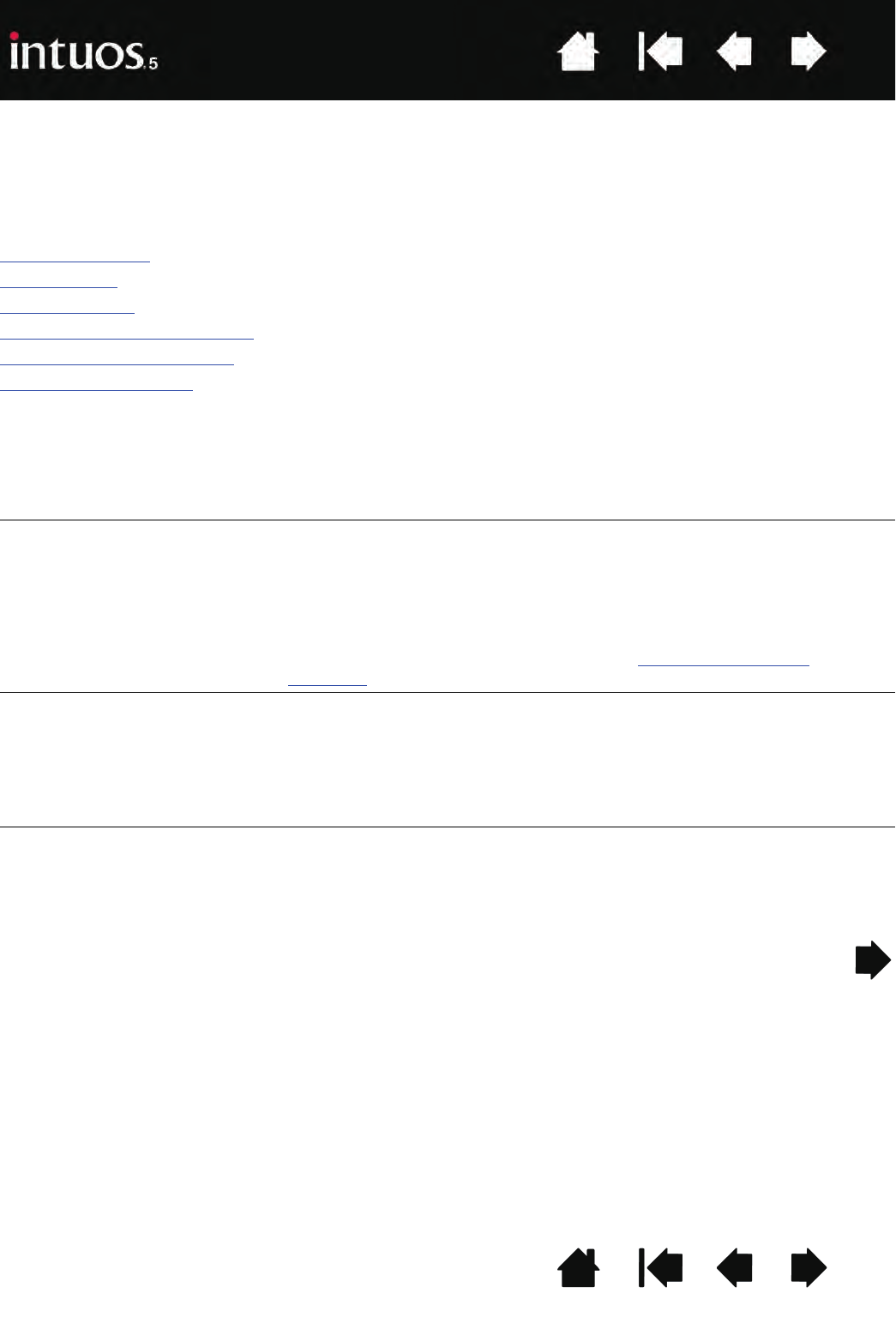
94
IndexContents
94
IndexContents
TROUBLESHOOTING TABLES
If you encounter problems with your Intuos tools or tablet, see the following tables. Your problem may be
described here, and you can try the solution offered. Check the tablet Read Me file for the latest
information updates.
For additional information, visit the Wacom web site at http://www.wacom.com .
General problems
Pen problems
Touch problems
Wireless connection problems
Windows-specific problems
Mac-specific problems
GENERAL PROBLEMS
The computer does not have
an available USB port.
Check if there is an available USB port on a USB hub. If not available
you will need to add a USB hub or USB card.
The tablet status LEDs do not
illuminate.
Verify that the tablet USB cable is properly connected to the tablet and
to an active USB port.
If connecting to a USB hub device, make sure the hub is connected to
an active USB port and that the hub is active.
Try also connecting to another USB port or using another USB cable.
If using Intuos in wireless mode, see also wireless connection
problems.
The computer does not go to
sleep.
When you are not using your Intuos input tool(s), remove them from the
tablet surface or the tablet will continue to send data, keeping the
computer awake.
Note: Because some metallic or other conducting objects can also
cause the tablet to send data, it is best to keep the tablet
surface clear of all objects when not in use.
The screen cursor is very
erratic or “jumps” around
when using the tablet.
On rare occasions the tablet may receive interfering radio frequencies
from a computer monitor or nearby AM radio station. If you notice
interference from a monitor, try moving the tablet at least six (6) inches
away from the monitor, or change the monitor refresh rate or monitor
resolution.
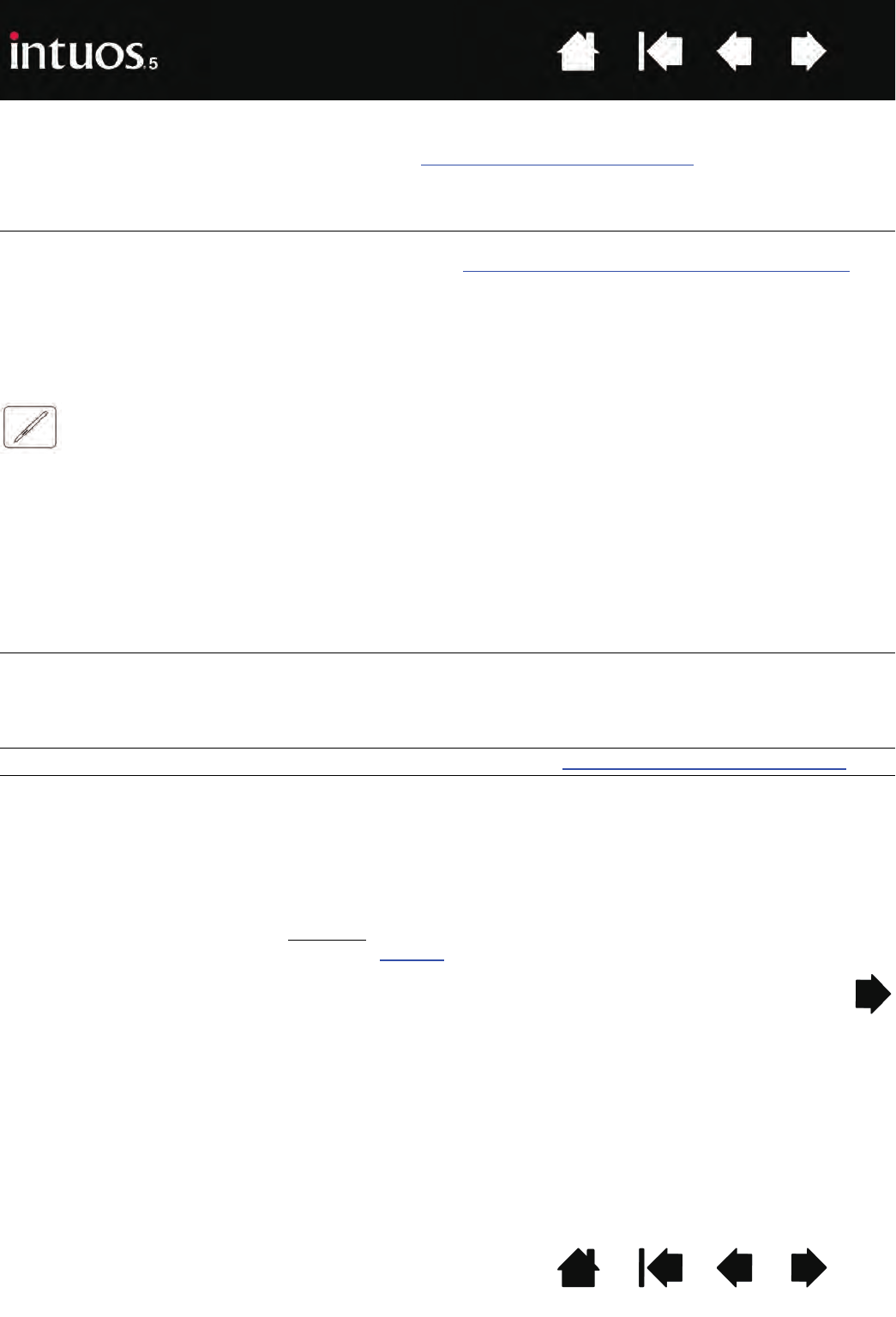
95
IndexContents
95
IndexContents
PEN PROBLEMS
The tablet is set to
EXPRESSKEYS RIGHT (or
EXPRESSKEYS LEFT), but at the
log on screen the tablet seems
to work upside down.
Reinstall the tablet driver software and change the default orientation of
the tablet. See configuring the tablet orientation.
When working in some
applications, the ExpressKeys
or Touch Ring perform a
different function than what is
set in the Wacom Tablet
control panel.
Some applications can override and control the ExpressKey and Touch
Ring functions. See using applications integrated for tablet control.
If using application-specific settings, be sure you have updated the
settings for the application you are working with.
The pen does not position the
screen cursor, or otherwise
work properly.
If the tablet driver does not load properly, pen input will not be
available.
• You will be able to use the pen tip to move the screen cursor and
click, but there will be no other pen functionality.
• For tablet models that combine pen input and touch, basic touch
movement will continue to be recognized but other actions and
gestures will not.
Install the driver software for the tablet.
The pen does not draw or ink
with pressure sensitivity.
Some applications require that you turn on the pressure capabilities
within the application or the selected tool before the pen will respond
as a pressure-sensitive tool.
Verify also that your application supports pressure sensitivity.
Clicking is difficult. Try using a lighter TIP FEEL. See adjusting tip feel and double-click.
Double-clicking is difficult. Be sure you are quickly tapping the tablet twice in the same place on
the tablet active area. Wacom recommends using the side switch to
double-click.
Open the Wacom Tablet control panel and go to the PEN tab.
Try increasing the TIP DOUBLE CLICK DISTANCE or using a lighter TIP FEEL.
Set an ExpressKey to DOUBLE CLICK and use it to issue double-clicks.
Windows: Try setting your system to launch programs with a single
click. See clicking.
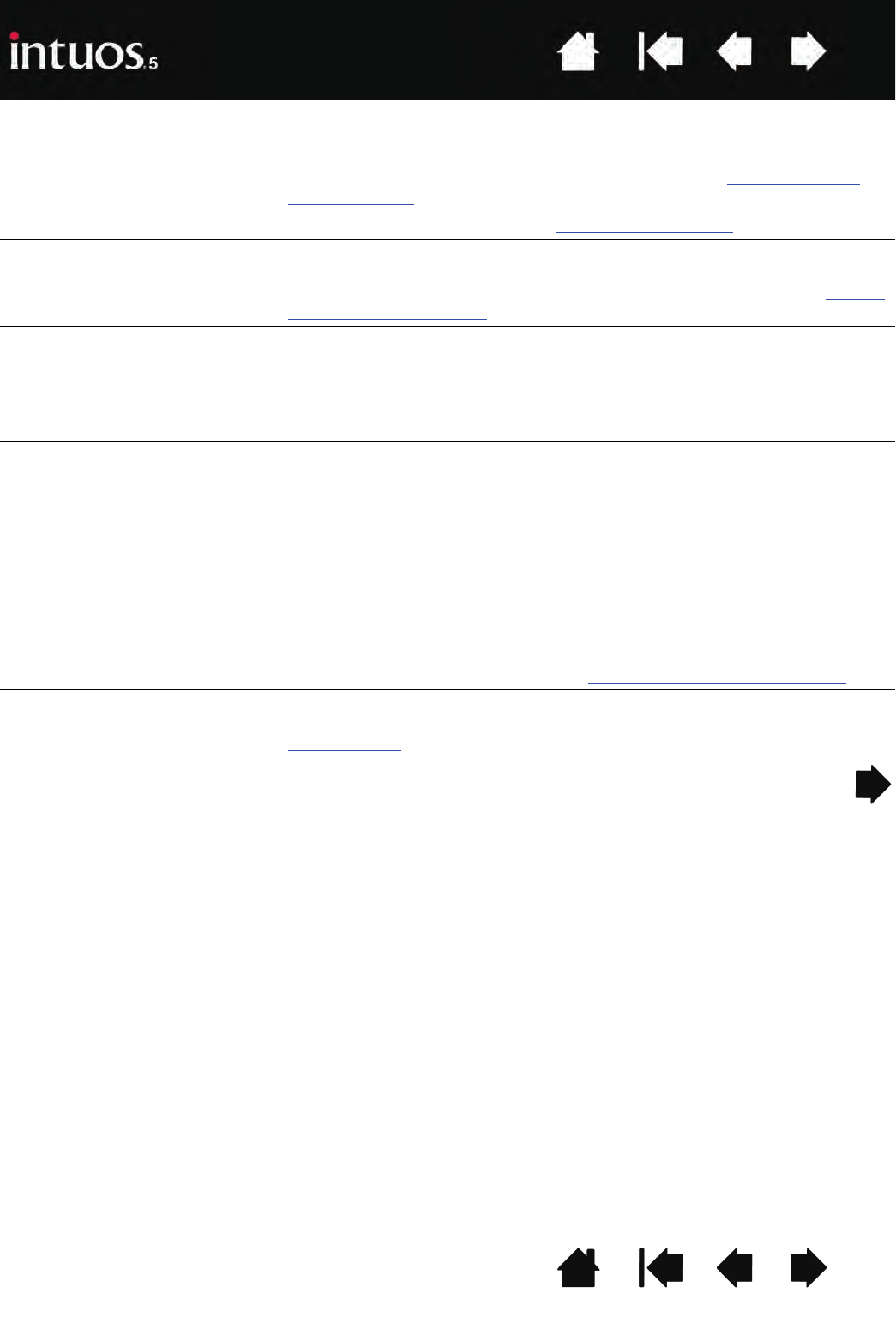
96
IndexContents
96
IndexContents
The pen selects everything,
will not stop drawing.
Open the Wacom Tablet control panel and go to the PEN tab. Move the
TIP FEEL slider toward FIRM, or select CUSTOMIZE... and increase the
CLICK: THRESHOLD setting. If this does not help, see testing controls
and input tools.
The pen nib may be worn. See replacing the pen nib.
The eraser selects everything
or will not stop erasing.
Open the Wacom Tablet control panel and go to the ERASER tab.
Move the ERASER FEEL slider toward FIRM, or select CUSTOMIZE... and
increase the CLICK: THRESHOLD setting. If this does not help, see te st i ng
controls and input tools.
You notice a screen delay at
the beginning of pen or inking
strokes.
Open the Wacom Tablet control panel and go to the PEN tab.
Try decreasing the TIP DOUBLE CLICK DISTANCE. If that does not work,
move the TIP DOUBLE CLICK DISTANCE slider to the OFF position in order
to turn off double-click assist.
Try turning off the operating system inking features.
You have to press hard with
the pen when clicking,
drawing, or writing.
Open the Wacom Tablet control panel and go to the PEN tab. Move the
TIP FEEL slider toward SOFT, or select CUSTOMIZE... and decrease the
SENSITIVITY and CLICK: THRESHOLD settings.
The pen tip does not function. Be sure you are using only a compatible pen or Wacom input device,
such as the pen that shipped with your product, or a Wacom accessory
pen specified for use with Intuos5. Other pens may not function
properly on the tablet.
Check the control panel PEN tab and verify that a CLICK function is
assigned to the tip.
A tablet status LED should brighten when the tip is pressed. If not, you
may have defective hardware. See testing controls and input tools.
Changing the settings of an
input tool has no effect.
Make sure you are changing the settings for the tool and application
that you are using. See application-specific settings and working with
multiple tools.
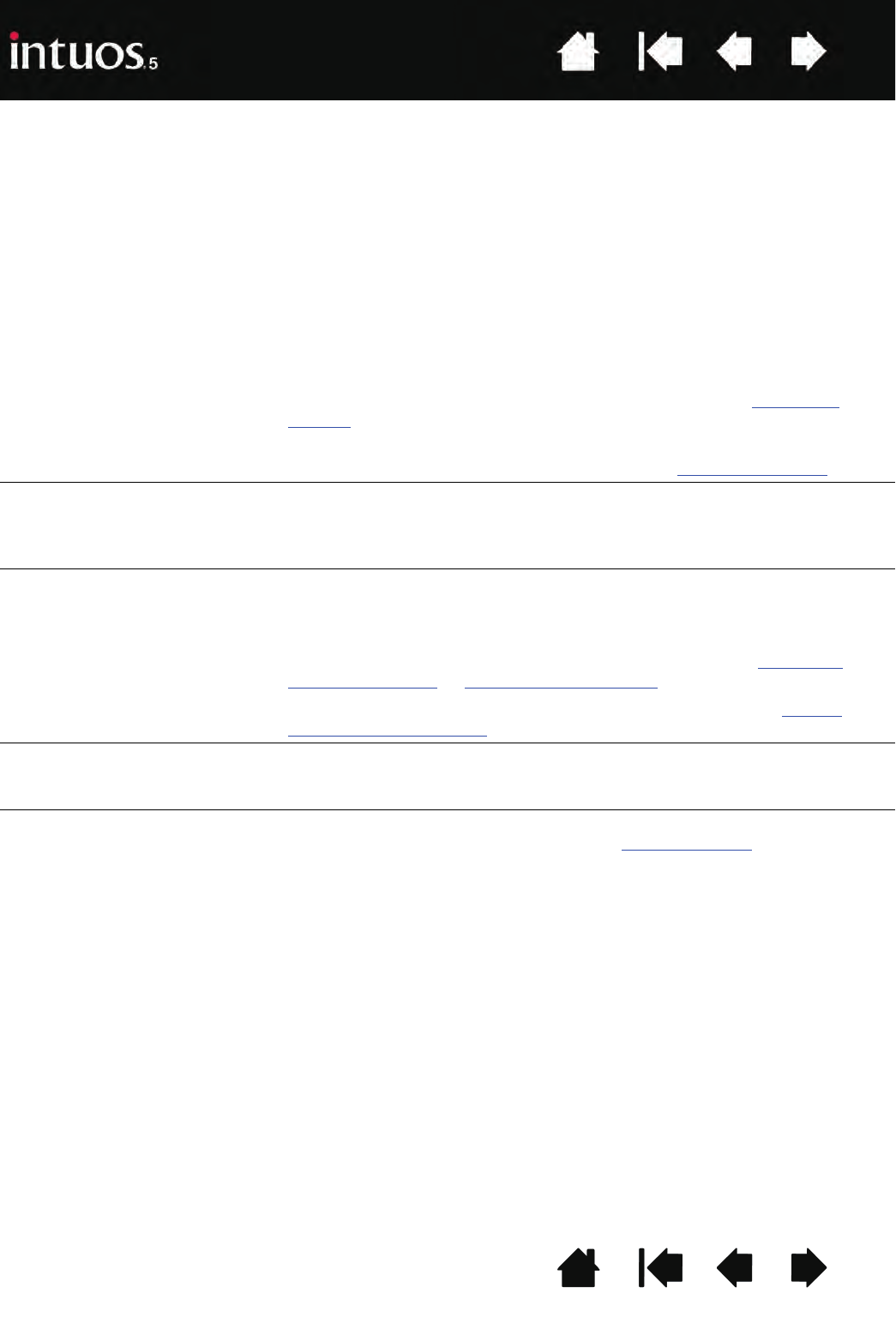
97
IndexContents
97
IndexContents
The pen side switch does not
work.
Be sure you are using only a compatible pen or Wacom input device,
such as the pen that shipped with Intuos5, or a Wacom accessory pen
specified for use with Intuos5. Other pens may not function properly
on the tablet.
Be sure to press the side switch when the pen tip is within 10 mm
(0.4 inch) of the tablet active area. Do this without pressing down on
the pen tip.
In the Wacom Tablet control panel, verify that the side switch is set to
the function you are expecting to occur for the application and tool you
are using.
Check also the SIDE SWITCH MODE. If CLICK & TAP is selected, you will
need to first press the side switch while touching the pen tip to the
tablet surface in order to perform a click function. See advanced
options.
A tablet status LED should brighten when you press the side switch.
If not, you may have defective hardware. See testing your tablet.
The screen cursor “jumps”
back.
Do not place an Intuos tool on the tablet when it is not in use, or when
you are using another pointing device. Leaving your tool on the tablet
may interfere with screen cursor positioning when using other input
devices.
Cannot move the cursor
where you want to on the
screen, or the line you are
drawing does not line up with
the location of the pointer in
paint applications.
Open the Wacom Tablet control panel and go to the MAPPING tab.
Verify that PEN MODE is selected and that the SCREEN AREA is set to
FULL for the selected tool and application. If this does not help, click on
the DEFAULT button to reestablish tablet to screen mapping. If you are
still having difficulty, remove the tablet preferences (see Windows-
specific problems or Mac-specific problems).
Confirm whether the pen does (or does not) function. See te s t in g
controls and input tools.
When using the pen to operate
the Touch Ring, the Touch
Ring does not work well.
The Touch Ring is designed to be used with your finger, and does not
work with the pen tip.
When using Intuos on a
multiple monitor system, you
cannot use the pen to control
the other monitor(s).
Cycle pen control for Intuos between your displays by pressing an
ExpressKey or pen button that is set to DISPLAY TOGGLE.
Verify that the SCREEN AREA in the MAPPING tab is set to FULL.
You can also use your pen to control the other monitors in mouse
mode. To use mouse mode, first set a pen button to MODE TOGGLE....
Then use the button to toggle between PEN MODE and MOUSE MODE.

98
IndexContents
98
IndexContents
TOUCH PROBLEMS
Touch does not work. Enable touch by pressing an ExpressKey that is set to TOUCH ON/OFF.
Otherwise, open the Wacom Tablet control panel, click on the TOUCH
icon, and go to the STANDARD GESTURES, MY GESTURES, or TOUCH
OPTIONS tab. Be sure the ENABLE TOUCH option is selected.
Touch does not seem to fully
work. The screen cursor can
be moved, but more complex
actions or gestures do not
work.
If the tablet driver does not load properly, basic touch movement will be
recognized but other actions and gestures will not. Install the driver
software for the tablet.
The tablet does not reliably
recognize multi-finger touch.
If you hold your fingers too close together, the tablet may not recognize
them as being separate. Try moving your fingers a little further apart.
Cannot zoom-in or zoom-out
when working with Adobe
Photoshop.
If zoom functions do not operate correctly within Photoshop, verify that
the ZOOM WITH SCROLL WHEEL function is not selected within the
Photoshop PREFERENCES options.
Scrolling and panning
gestures do not function
correctly when working with
Adobe Photoshop.
If touch gestures do not operate correctly within Photoshop, verify that
the ZOOM WITH SCROLL WHEEL function is not selected within the
Photoshop PREFERENCES options.
Rotation gestures do not seem
to work consistently, or not at
all.
Rotation may work differently depending on the application you are
working with. For example, rotation may work smoothly, in 90-degree
increments, or not at all.
For best recognition of this gesture, start with your fingers positioned
diagonally on the tablet surface and keep them at least 25 mm (1 inch)
apart.
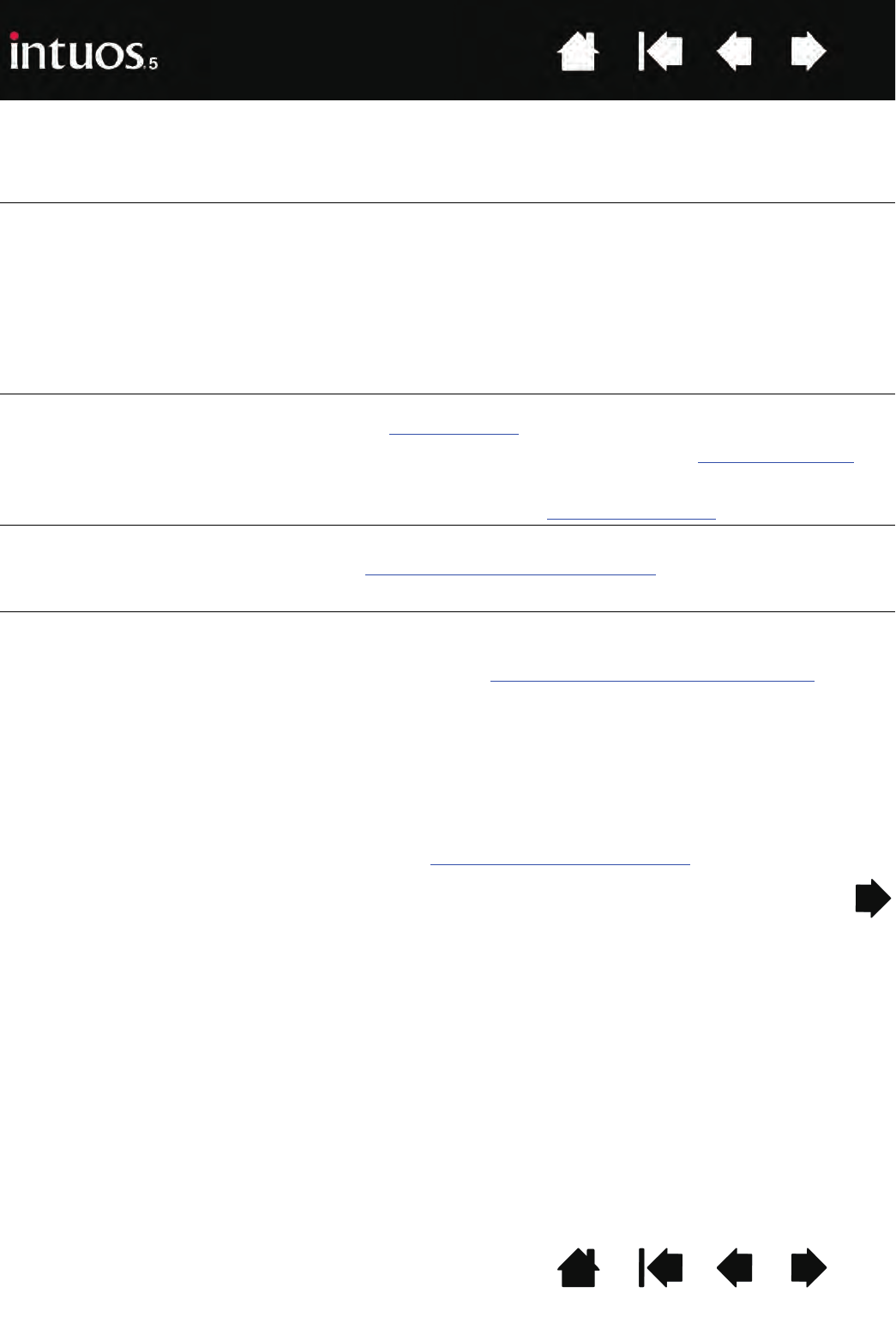
99
IndexContents
99
IndexContents
WIRELESS CONNECTION PROBLEMS
The computer does not have
an available USB port.
Check if there is an available USB port on a USB hub. If not available,
add a USB hub or USB card.
After pressing the power
button on the wireless module,
the tablet status LED glows
steadily for 4 seconds and
then turns off.
If a wireless connection is not established, the wireless module will turn
off after 4 seconds.
• Make sure the wireless receiver is properly connected to an active
USB port on your computer or USB hub.
• Move the tablet closer to the antenna and make sure there are no
metal or other high-density obstructions in the line of sight between
the tablet and your computer.
Again press the power button to activate the connection.
After turning on the wireless
module, the status LED
indicates good functionality
but the screen cursor cannot
be moved.
If your tablet model supports touch, be sure you have not turned off
touch. See disabling touch.
Be sure you are using the pen correctly. Review using the Grip Pen.
Switch the wireless module off, then back on.
If the battery charge is low, try charging the battery.
A wireless connection has
been made, but the tablet
does not seem to work
correctly.
Be sure you have correctly installed the tablet driver software.
See also optimizing the wireless connection.
The tablet works when
connected with the USB
cable, but turns off as soon as
the cable is disconnected.
Confirm the wireless module and receiver are correctly installed, and
that the wireless module is turned on.
Check the battery. See battery and wireless connection status.
• Open the tablet wireless compartment cover and verify that the
battery is properly installed.
• Check the battery appearance to ensure there is no leakage or
other indication of damage.
• Charge the battery overnight and try again. If the problem persists,
the battery may be completely discharged or damaged and can no
longer hold a charge. You will have to purchase a replacement
battery. See ordering parts and accessories.

100
IndexContents
100
IndexContents
The tablet status LED does
not illuminate after pressing
the power button on the
wireless module.
Try again. Then:
1. Verify the Wacom wireless receiver is properly connected to an
active USB port. If connecting to a USB hub, make sure the hub is
connected to an active USB port and that the hub is active.
2. Verify the Wacom wireless module is properly installed in the tablet.
Press the power button to connect wirelessly.
3. If the tablet status LED still does not light, connect the USB cable
between your tablet and computer.
On the wireless module, check the battery status LED.
Amber indicates the battery is charging. Green indicates the
battery is fully charged. If the LED remains off, the battery may be
defective. Replace the battery.
4. If both the tablet status and wireless module LEDs remain off, then
contact the Wacom support staff for the area where your product
was purchased. See technical support options.
When using the tablet, the
screen cursor or pen strokes
seem to lag or skip in some
applications.
See optimizing the wireless connection for tips on improving the
connection.
The battery charging process
seems to stop whenever the
computer enters sleep mode.
As required, adjust your system power or energy saver settings so that
the computer does not enter sleep mode while the tablet battery is
charging.

101
IndexContents
101
IndexContents
WINDOWS-SPECIFIC PROBLEMS
You suspect the tablet
preferences may be
corrupted, or want to make
certain that all settings are at
their factory defaults.
Use the Wacom Tablet Preference File Utility to work with preferences.
Close any open applications. Click the START icon and select ALL
PROGRAMS. Then select WACOM TABLET and WACOM TABLET PREFERENCE
FILE UTILITY.
• It is a good idea to first back up your tablet preferences. In the
TABLET PREFERENCE FILE UTILITY dialog box, click BACKUP... and
follow the prompts.
• Then, use the Tablet Preference File Utility to delete the tablet
preferences as follows:
Single user. Under MY PREFERENCES, click REMOVE to delete the
preferences for the current user.
Multiple users. Under ALL USER PREFERENCES, click REMOVE to
delete preferences for multiple users. Administrator rights are
required to delete preferences for all users. Relaunch any currently
open tablet-aware applications that you may be running.
You can quickly restore tablet preferences that have been backed up
by clicking RESTORE... under MY PREFERENCES.
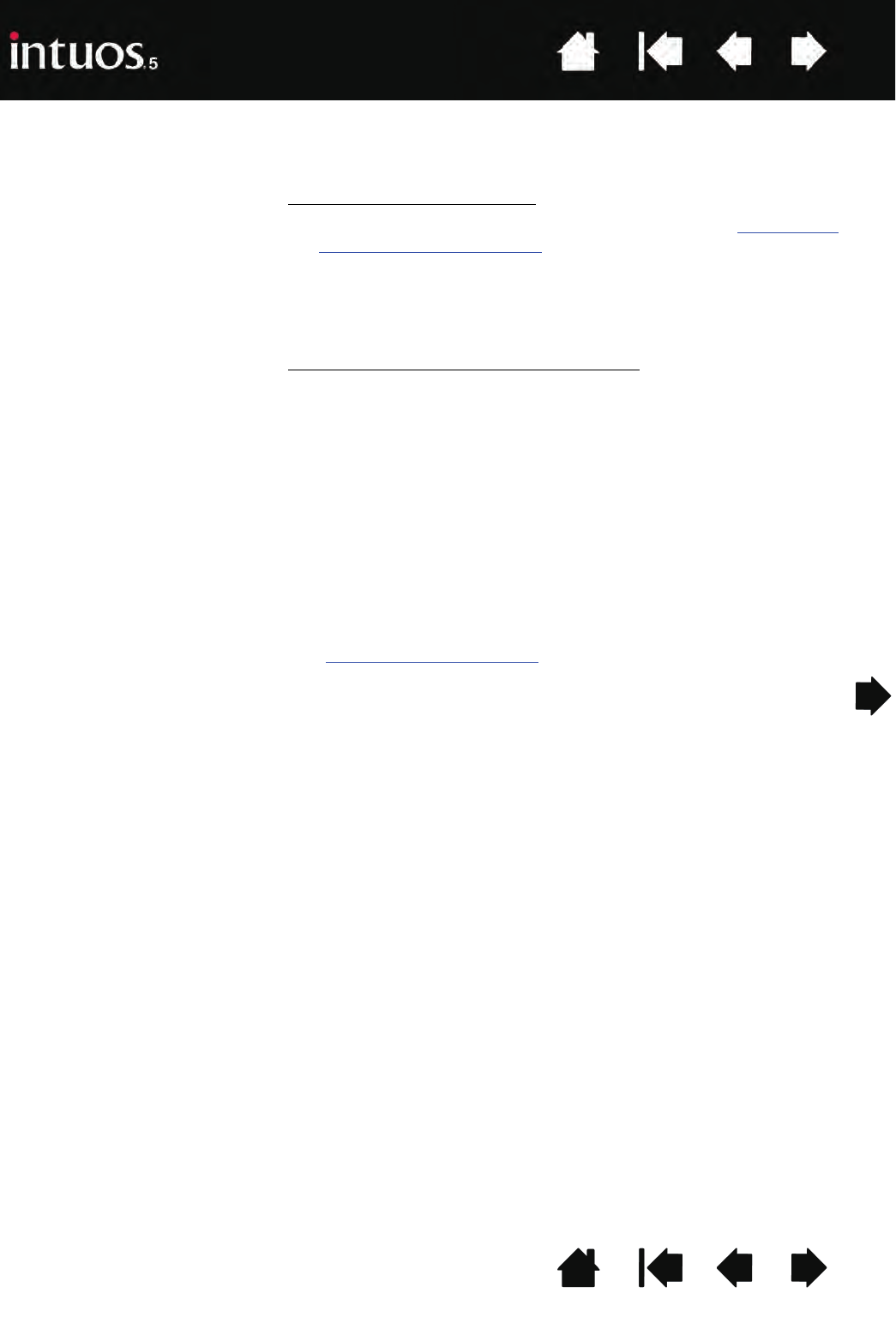
102
IndexContents
102
IndexContents
MAC-SPECIFIC PROBLEMS
At startup, a dialog box
appears telling you that either
the driver failed to load or the
tablet preferences have not
yet been created.
The tablet was not detected at startup.
If using a wireless connection:
• Make sure the wireless connection is active. See battery and
wireless connection status.
•From the G
O menu, select UTILITIES and launch the SYSTEM
PROFILER. Select USB from the HARDWARE section of the CONTENTS
list. A Wacom USB tablet model should be listed. If a tablet model
is not listed, check the wireless connection.
If connected with the provided USB cable:
• Make sure the USB cable is securely connected to an active USB
port on your computer or USB hub. Check to be sure that a tablet
status LED is illuminated. If your tablet is plugged into a USB hub,
make sure the hub is connected and active.
•From the G
O menu, select UTILITIES and launch the SYSTEM
PROFILER. Select USB from the HARDWARE section of the CONTENTS
list. A Wacom USB tablet model should be listed. If a tablet model
is not listed, check the USB tablet cable connection or try plugging
the tablet into a different USB port.
If you are still having difficulties, uninstall then reinstall the tablet driver
software.
If this does not help, contact Wacom for Technical Support.
See technical support options.

103
IndexContents
103
IndexContents
You suspect the tablet
preferences may be
corrupted, or want to make
certain that all settings are at
their factory defaults.
Use the Wacom Tablet Utility to work with your preferences. Close any
open applications. Open the main APPLICATIONS folder. Then open the
WACOM TABLET folder and run the WACOM TABLET UTILITY.
• It is a good idea to first back up your tablet preferences. In the
Wacom Tablet Utility, select CURRENT USER or ALL USERS. Then click
BACKUP... and follow the prompts.
• Then, delete the tablet preferences as follows:
Single user. When the utility starts, select CURRENT USER and click
REMOVE. Log out, then log back in. When the tablet driver loads it
will create a new preferences file with the factory defaults.
Multiple users. When the utility starts, select ALL USERS and click
REMOVE. Log out, then log back in. When the tablet driver loads it
will create new preferences files with the factory defaults.
You can quickly restore tablet preferences that have been backed up
for the CURRENT USER or ALL USERS by clicking RESTORE... within the
utility.
Note: Do not manually remove the WACOM TABLET.PREFPANE file from
the main LIBRARY PREFERENCEPANES folder. This file is only to be
removed when uninstalling the Wacom software driver, and then
only when using the Wacom Tablet Utility.
Ink does not work correctly
with Intuos.
There may be a problem with the Ink preferences. Remove the
damaged preference files as follows. They will be re-created when you
enable handwriting recognition.
1. Open SYSTEM PREFERENCES, choose SHOW ALL and select INK.
Then turn off handwriting recognition.
2. From the GO menu, choose your HOME. Open the LIBRARY and
PREFERENCES folders. Remove the following preferences:
•COM.APPLE.INK.FRAMEWORK.PLIST
•COM.APPLE.INK.INKPAD.PLIST
•COM.APPLE.INK.INKPAD.SKETCH
3. Go back to SYSTEM PREFERENCES and INK, and then enable
handwriting recognition.
4. Test the Ink function using your Wacom tablet and pen.
If this procedure does not resolve your problem with Ink, contact Apple
Support for further assistance. Wacom is not the software
manufacturer for Ink and we are limited in our abilities to support a
third-party software application.

104
IndexContents
104
IndexContents
TECHNICAL SUPPORT OPTIONS
If you have a problem with your tablet, first check the tablet installation guide to be sure the unit is installed
correctly. Then review the troubleshooting procedures.
If you cannot find the answer in this manual, you may find updated information about your problem in the
appropriate Read Me file for your platform (located on the Intuos installation CD). You can also visit
www.wacom.com where you can choose the Wacom web site for your region and check the product FAQs
(Frequently Asked Questions).
If you have an Internet connection you can download the latest software drivers from the Wacom web site
for your region. See obtaining driver downloads.
Check the Customer Care options on the Wacom web site for your region. You may find answers to your
question without having to make a phone call.
If you cannot solve the problem and you think your tablet is not working properly, contact the Wacom
Customer Care staff for the area where your product was purchased. See the tablet Read Me file, located
on the Intuos installation CD, for contact information. You can also find contact information by checking
the Wacom web site for your region.
When you call, you should be at your computer with the following information available:
• This manual.
• Tablet serial and model number. (Look on the bottom of the tablet.)
• Driver version number. (See the Intuos installation CD or click on the Wacom Tablet control panel
ABOUT button.)
• The make and model of your computer, and operating system version number.
• A list of peripheral devices attached to your computer.
• The software application and version you were using when the problem occurred.
• The exact wording of any error message that appeared on your screen.
• What happened and what you were doing when the problem occurred.
• How you tried to solve the problem.
You can also contact the Wacom Customer Care Center by visiting the Wacom web site for your region and
completing an Email Inquiry form.

105
IndexContents
105
IndexContents
OBTAINING DRIVER DOWNLOADS
Wacom periodically updates the tablet software driver to maintain compatibility with new products. If you
are having a compatibility problem between Intuos and a new hardware or software product, it may be
helpful to download a new software driver (when available) from the Internet.
USA, Canada, Central and South America
Europe, Middle East and Africa
Japan
Asia Pacific (English)
China
Hong Kong
Korea
Ta i w a n
Worldwide Web: http://www.wacom.com Software updates
Worldwide Web: http://www.wacom.eu/downloads Software updates
Worldwide Web: http://tablet.wacom.co.jp/download Software updates (Japanese)
Worldwide Web: http://www.wacom.asia Software updates (English)
Worldwide Web: http://www.wacom.com.cn Software updates
(Simplified Chinese)
Worldwide Web: http://www.wacom.com.hk Software updates
(Traditional Chinese)
Worldwide Web: http://www.wacomkorea.com Software updates (Korean)
Worldwide Web: http://www.wacom.com.tw Software updates
(Traditional Chinese)

106
106
IndexContents
IndexContents
APPENDIX
This section contains tips on caring for Intuos, instructions on how to uninstall the tablet software,
information about digital inking, and more.
Caring for Intuos
Replacing the pen nib
Uninstalling Intuos
Using the Express View display
Managing preferences
Installing multiple tablets
Using applications integrated for tablet control
Importing expert settings
Using the optional Airbrush and Art Pen
Using the optional Intuos Mouse
Pen and digital ink capabilities in Windows
Product information
Ordering parts and accessories
Available parts and accessories
CARING FOR INTUOS
Keep your Intuos tools and tablet surface clean. Dust and dirt particles can stick to your tools and cause
excessive wear to the tablet surface. Regular cleaning with a soft, damp cloth will help to prolong the life of
your tablet surface and tools. You can also dampen the cloth using a very mild soap diluted with water.
Do not use volatile liquids, such as paint thinner or benzene, because they may damage the plastic case.
Keep Intuos in a clean, dry place and avoid extremes in temperature. Room temperature is best.
Also, your Intuos tablet and tools are not made to come apart. Twisting the pen case can break the pen.
Taking apart the product will void your warranty.
Important: Take care to never spill liquids onto the tablet or input tools. Be especially careful of
getting the tablet or tool buttons (including the pen tip and eraser) wet. They contain sensitive
electronic parts that will fail if liquids enter them.
Prevent scratching by replacing your pen nibs frequently. When the nibs are worn or pointed they can
damage your tablet. See replacing the pen nib.
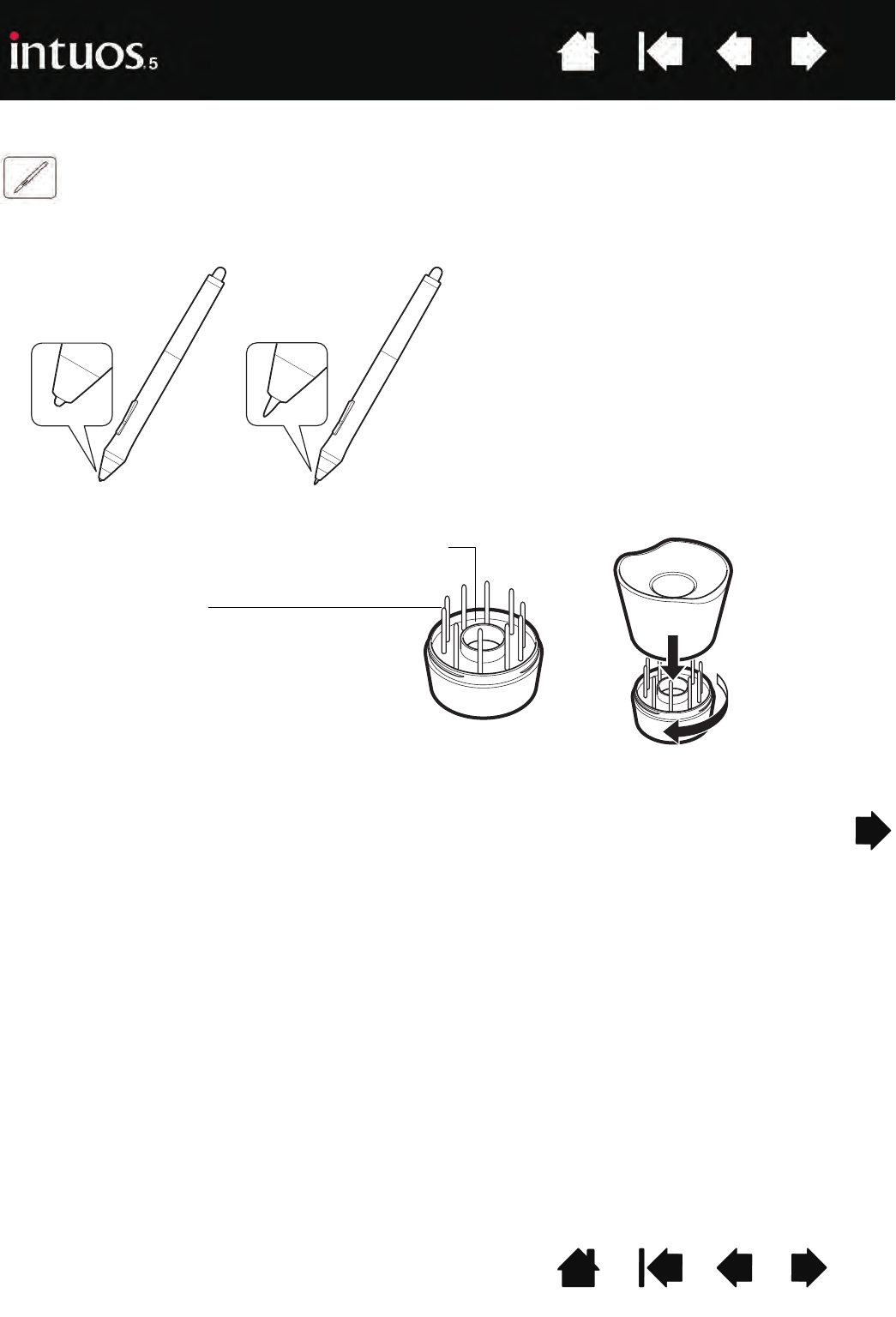
107
IndexContents
107
IndexContents
REPLACING THE PEN NIB
To protect your tablet from scratching and for best performance, periodically replace your pen nibs.
Important: Replace the pen nib before or when it looks like this:
1. Unscrew the pen stand base to access the nib removal tool and replacement nibs.
2. Clasp the old nib and pull it straight out of the pen. Use the nib removal tool, pair of tweezers,
needle-nosed pliers, or similar instrument.
The pen nib (tip) will wear with normal use.
Excessive pressure will cause it to wear
sooner.
Replace the nib when it gets too short or
develops a flat point.
Nib removal tool
Replacement nibs
• 5 standard nibs, black
• 1 flex nib, white and black
• 1 stroke nib, white
• 3 hard felt nibs, gray
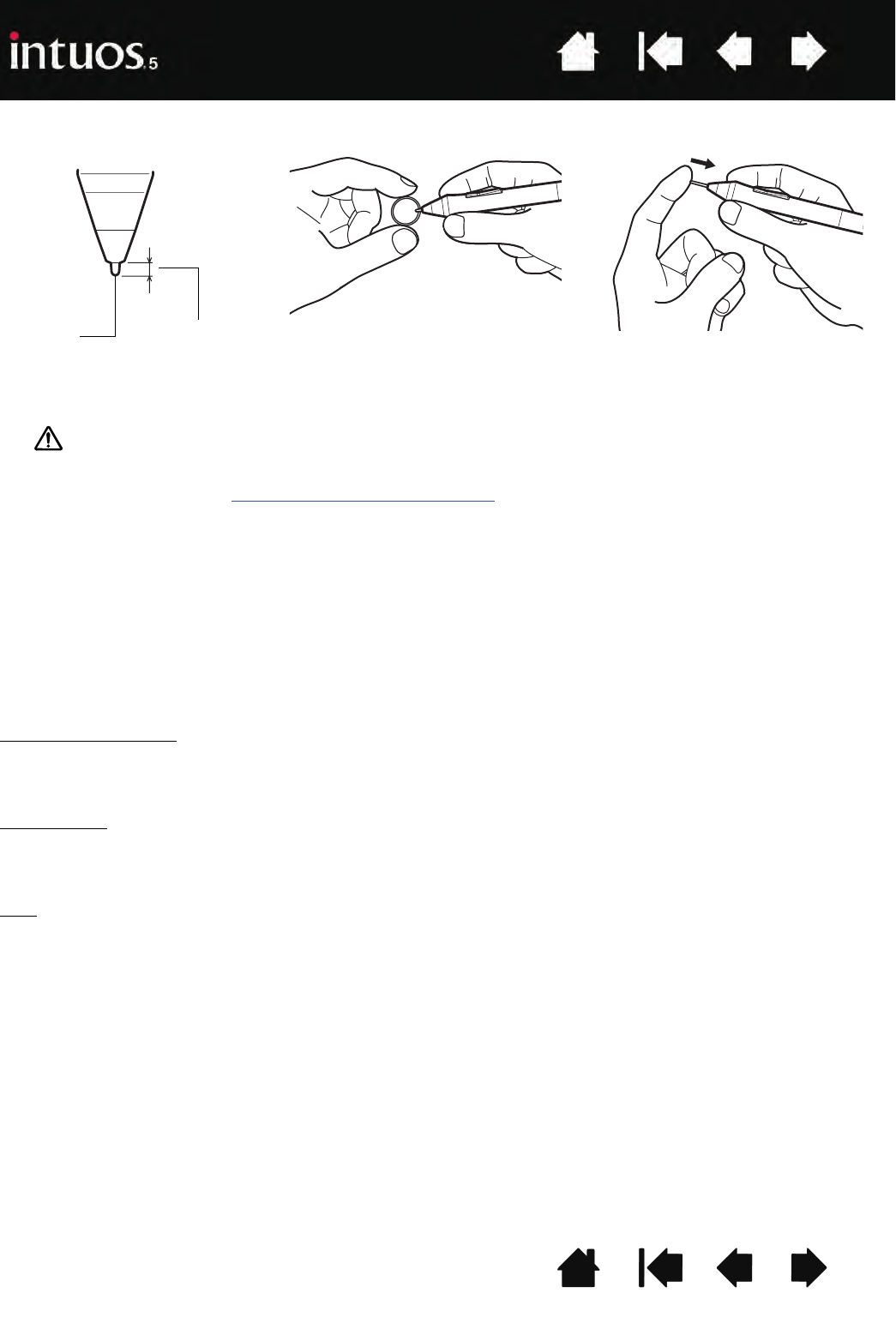
108
IndexContents
108
IndexContents
3. Slide the end of the new nib straight into the barrel of the pen. Firmly push the nib until it stops.
Warning: Choking hazard. Prevent children from swallowing the pen nib or side switch.
The pen nib or side switch may accidentally be pulled out if children are biting on them.
For replacement parts, see available parts and accessories.
Important: When not in use, place the pen in the pen stand or lay it flat on your desk. When the
optional Airbrush is not in use, lay it flat on your desk. To maintain the sensitivity of your input tools,
do not store them in a container where they will rest on their tip or eraser.
UNINSTALLING INTUOS
Follow the appropriate procedure below to remove the tablet driver software from your system.
Important: When you remove the tablet software, your tablet will no longer operate with full tablet
functionality but will continue to function as a mouse device.
Windows 7 and Vista: Click on the Windows START button and open the CONTROL PANEL. In the CONTROL
PANEL window click on UNINSTALL A PROGRAM. In the dialog box that appears, choose WACOM TABLET and
click UNINSTALL. Follow the prompts to remove the tablet driver. If prompted, enter your administrator log
on name and password. Restart your computer after uninstalling the software.
Windows XP: Click on the Windows START button and open the CONTROL PANEL. In the CONTROL PANEL
window select ADD OR REMOVE PROGRAMS. In the ADD OR REMOVE PROGRAMS window, choose WACOM
TABLET and click REMOVE. Follow the prompts to remove the tablet driver. If prompted, enter your
administrator log on name and password. Restart your computer after uninstalling the software.
Mac: From the GO menu, choose APPLICATIONS and open the WACOM TABLET folder. Double-click on the
WACOM TABLET UTILITY icon and select the TABLET SOFTWARE: REMOVE button. Enter your administrator log
on name and password. After the removal is completed, click OK. Restart your computer after uninstalling
the software.
Nib Replace when 1 mm (1/25 inch) or less.
Note: Stroke nibs are spring-loaded, providing additional tactile feedback when you are working with the Intuos
pen or optional Airbrush. They are installed in the same manner as a standard pen nib.
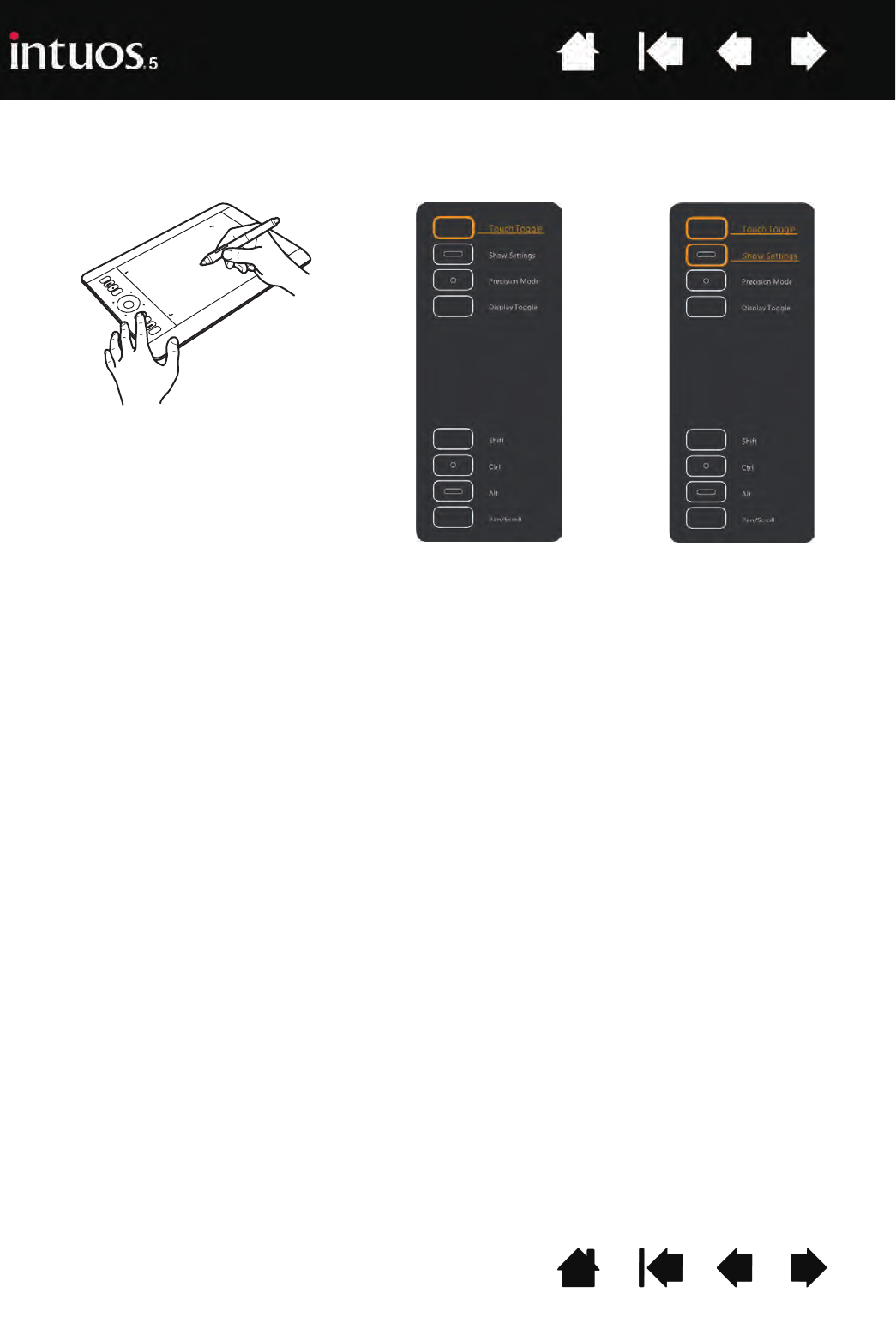
109
IndexContents
109
IndexContents
USING THE EXPRESS VIEW DISPLAY
Rest your finger on an ExpressKey to activate the Express View display on your primary monitor.
This display shows the current ExpressKey setting(s).
• The ExpressKey you touch appears hi-lighted in the display. Move your finger along the ExpressKeys
to hi-light other keys in the display. If an ExpressKey has been disabled, it will be shown as disabled or
there may be no display for that key.
• The display closes when you remove your finger from the ExpressKey, or if you rest your finger on the
key for an extended period of time.
Notes:
Pressing an ExpressKey will not activate the Express View display.
To disable the display, open the Wacom Tablet control panel and choose the EXPRESSKEYS tab.
Uncheck the SHOW EXPRESS VIEW box. Check the box to again activate the display.

110
IndexContents
110
IndexContents
MANAGING PREFERENCES
Use the Wacom tablet preferences utility to manage your tablet preferences for single or multiple users.
Windows: First close any open applications. Then open the utility by clicking the START icon and selecting
ALL PROGRAMS. Select WACOM TABLET and WACOM TABLET PREFERENCE FILE UTILITY.
• To remove preferences for the current user, click REMOVE under MY PREFERENCES.
• To delete preferences for multiple users, click REMOVE under ALL USER PREFERENCES.
Administrator rights are required to delete preferences for all users. Relaunch any currently open
tablet-aware applications that you may be running.
• To back up your preferences, click BACKUP... under MY PREFERENCES.
• To restore preferences that you had previously backed up, click RESTORE... under MY PREFERENCES.
• Carefully follow any prompts that may appear.
Mac: Open the main APPLICATIONS folder. Then open the WACOM TABLET folder and run the WACOM TABLET
UTILITY.
• To remove preferences, select CURRENT USER or ALL USERS. Then click REMOVE. Log out, then log back
in. When the software driver loads it will create a new preferences file with the factory defaults.
• To back up your preferences, select CURRENT USER or ALL USERS. Then click BACKUP....
• To restore preferences that you had previously backed up, select CURRENT USER or ALL USERS.
Then click RESTORE....
• Carefully follow any prompts that may appear.
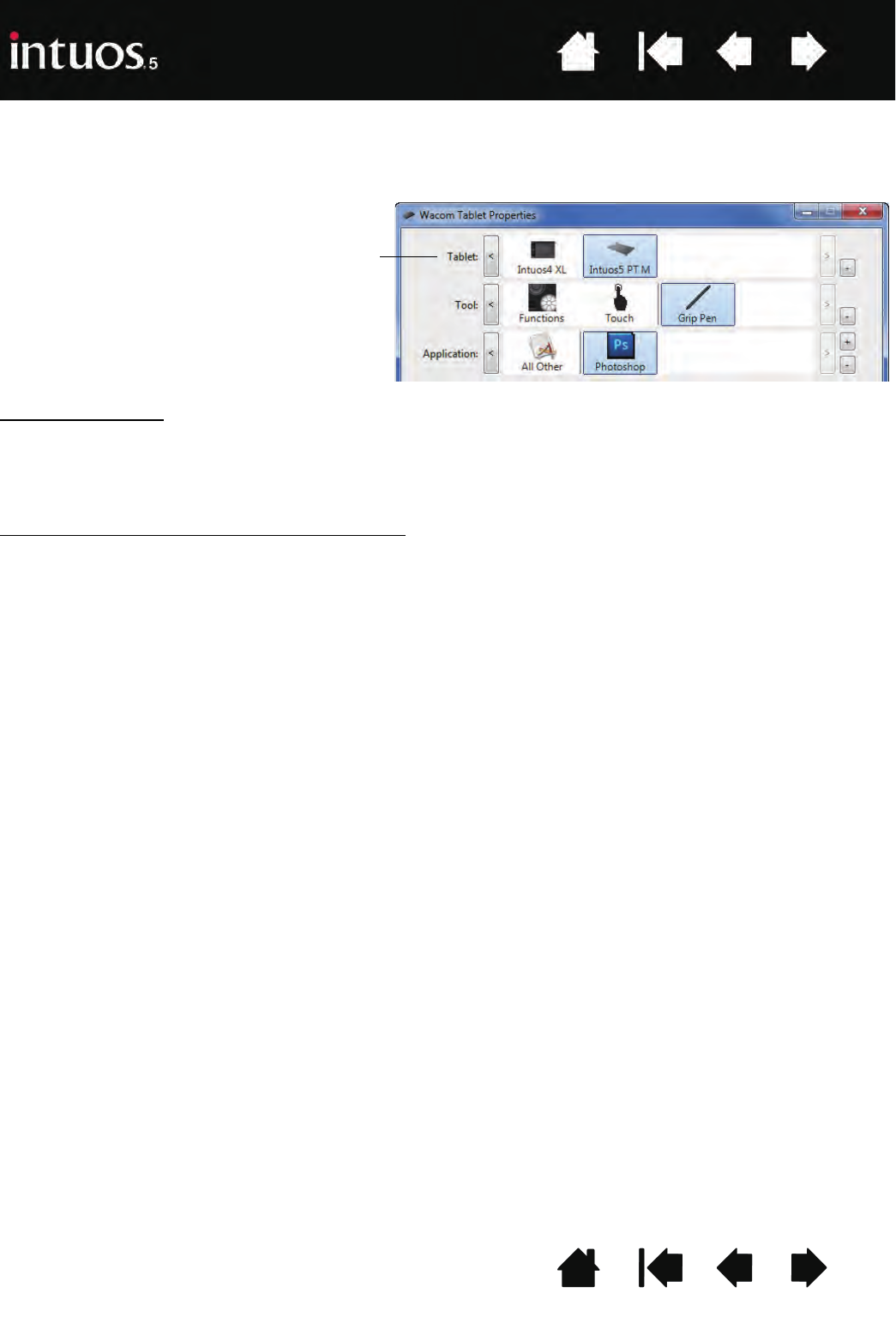
111
IndexContents
111
IndexContents
INSTALLING MULTIPLE TABLETS
Any tablet that has been detected on your system will appear as an icon within the Wacom Tablet control
panel TABLET list.
To add a new tablet, connect it to your computer. The system will automatically find the tablet and initialize
it. An icon for the tablet will then appear in the control panel.
Important: When installing additional tablets on Windows systems, the eraser function may not
work in some applications when using the additional tablet(s). The eraser function will continue to
work correctly using the first tablet that was added to the control panel.
To remove one of multiple tablets from the driver, select the tablet to be removed and click on the [ – ]
button next to the TABLET list.
• A tablet must be attached to the computer before it can be deleted from the control panel list.
• You will need to restart your computer before you can again add the tablet to the driver.
Select a tablet icon for which to customize tool
and application settings.
• The control panel will not launch unless a
supported tablet is connected to the
computer.
• Settings can only be viewed or changed for
an attached tablet.

112
IndexContents
112
IndexContents
USING APPLICATIONS INTEGRATED FOR TABLET CONTROL
Some software applications may be designed to directly control ExpressKey or Touch Ring function(s).
When working in an application that has been integrated in this manner, the ExpressKeys or Touch Ring
may perform differently than the function that is set in the Wacom Tablet control panel.
• When an ExpressKey is overridden by an application, the ExpressKey setting will automatically update,
using either the new function name or “Application Defined”. Some or all of the ExpressKeys may be
overridden, depending on the application.
• When an application overrides the Touch Ring, all Touch Ring modes are affected. If an application
overrides only some of the available Touch Ring functions, the remaining mode(s) are set to SKIP.
• An integrated application will control the ExpressKeys or Touch Ring only when that application is
active and in the foreground. When you close that application or select a new application pane to work
in, your Wacom Tablet control panel settings are returned to their previous state.
• To review the ExpressKey, Touch Ring, or pen settings for the current front-most application, set an
ExpressKey to SHOW SETTINGS and press the key at any time.
Applications that have been integrated in this manner will typically provide you with the opportunity to
opt-out or disable this functionality when first using your Wacom product with the application. See the
documentation provided with your application for any specific details on functionality and how to
customize or disable this feature.
If an automatic prompt or the application’s documentation does not describe how to disable this behavior,
you can use the Wacom Tablet control panel to create application-specific settings that will override the
behavior of the integrated application.
Important: If an application-specific setting has been created for an integrated application, setting
an ExpressKey or Touch Ring mode to APPLICATION DEFINED will still allow the integrated application
to control the function.

113
IndexContents
113
IndexContents
IMPORTING EXPERT SETTINGS
The import expert settings feature enables you to import customized Wacom Tablet control panel settings
that have been specified in an XML (Extensible Markup Language) file.
• Some software developers may create custom settings files which are specifically designed to provide
optimum performance when using your Wacom product with their applications.
• Visit the Wacom web site for your region to choose from a variety of custom settings files that may be
available for your product.
• Each XML file may include customized settings for one or more applications. These settings may apply
to the ExpressKeys, Touch Ring, Radial Menu, or pen button and eraser functions.
To import expert settings:
1. Choose an XML file with settings for use with a particular application. Double-click on your file
selection.
2. Carefully read and follow the instructions in the confirmation dialog.
• The utility will import settings for one or more applications. Any previous settings for those
applications may be overridden.
• You are encouraged to back up any existing control panel settings before importing the expert
settings.
• You can cancel, or continue to import the settings.
3. When you choose to import settings, only the settings specified in the XML file will be imported.
Any corresponding settings will be overridden with the new values. All other existing settings will
remain unchanged.
After the import process is completed you will have an opportunity to view the new settings within the
Wacom Tablet control panel.
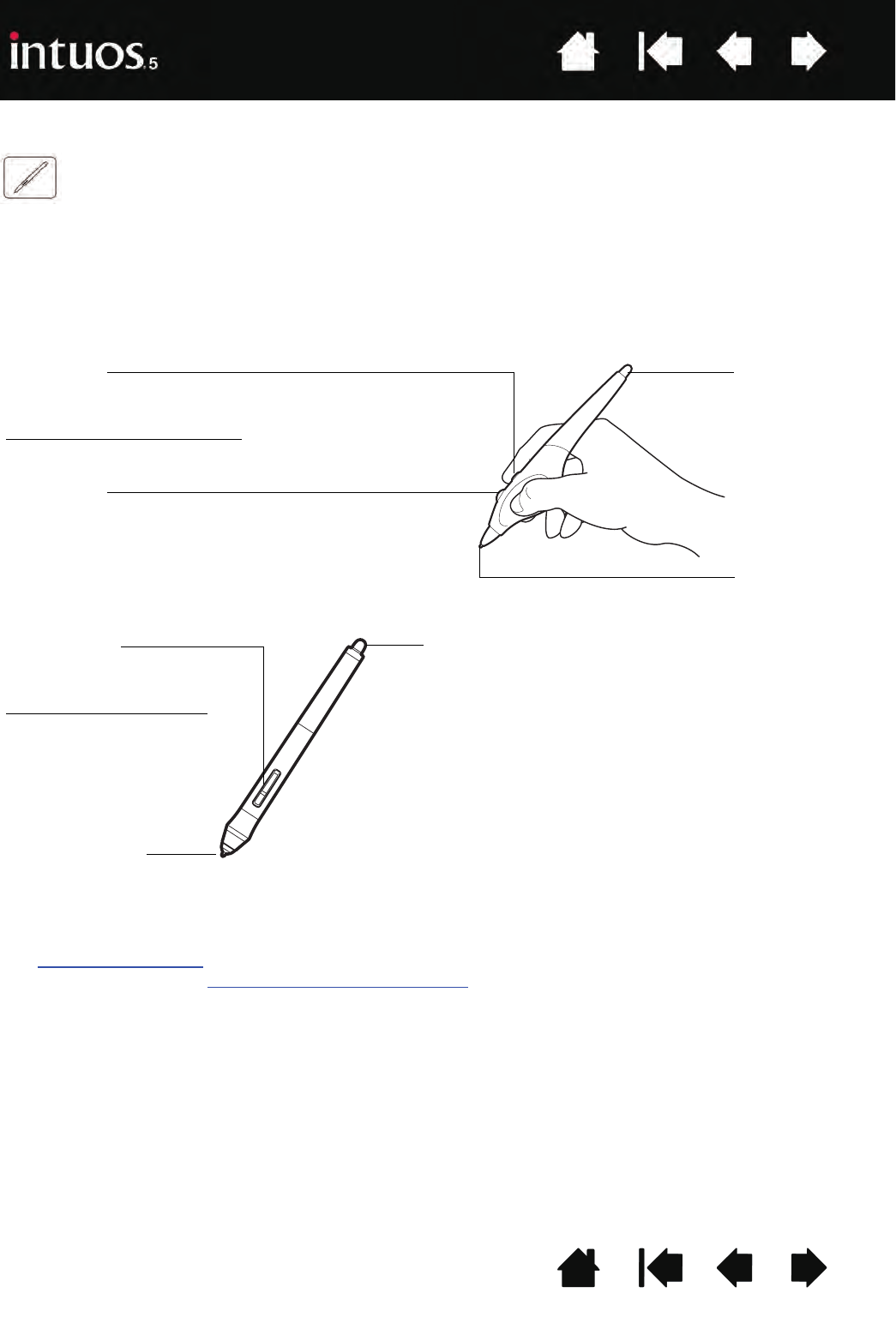
114
IndexContents
114
IndexContents
USING THE OPTIONAL AIRBRUSH AND ART PEN
The optional Intuos Airbrush works like the Grip Pen, and includes a fingerwheel for additional control.
Hold the Airbrush with your thumb and middle finger. The fingerwheel should be in a convenient location
for you to roll it with your index finger. Tilt the Airbrush for a comfortable position that allows you to paint
and draw with pressure sensitivity.
You can simulate realistic airbrushing with the proper software support. For example, apply pressure on
the tip to control the brush size. Tilt the Airbrush to elongate and feather the spray pattern. Roll the
fingerwheel to adjust the spray intensity.
The optional Intuos Art Pen responds to the pressure, tilt, and rotation you apply to the pen.
Important: When not in use, set the Airbrush or Art Pen flat on your desk. To maintain the sensitivity
of your tool, do not store it in a container where it will rest on its tip or eraser. Leaving an Intuos tool
on the tablet may interfere with screen cursor positioning when using other pointing devices.
See product information to learn more about which applications currently support the Airbrush fingerwheel
or Art Pen rotation. See ordering parts and accessories for information on where to purchase an Intuos
Airbrush or Art Pen.
Side switch
Default settings:
Windows: RIGHT CLICK
Mac: DOUBLE CLICK
Fingerwheel
Roll the fingerwheel backwards to increase ink
flow or brush size, and forward to reduce it.
Your index finger should operate the wheel
independently of the pressure you apply to the tip.
Eraser
Replaceable nib
Side switches
Default settings:
Upper: DOUBLE CLICK
Lower: RIGHT CLICK
Eraser
Does not support rotation.
Replaceable nib
The Art Pen supports 360 degrees of rotation around the pen axis.
As you draw within an application that supports rotation sensitivity,
simply twist the Art Pen to create lines that narrow or broaden.
While painting you can vary the rotation of a non-circular brush to
change the stroke thickness. Depending on the brush shape
characteristics you have selected in your application, you can
simulate calligraphy pens, broad felt tip markers, and any other non-
circular brushes or tools.
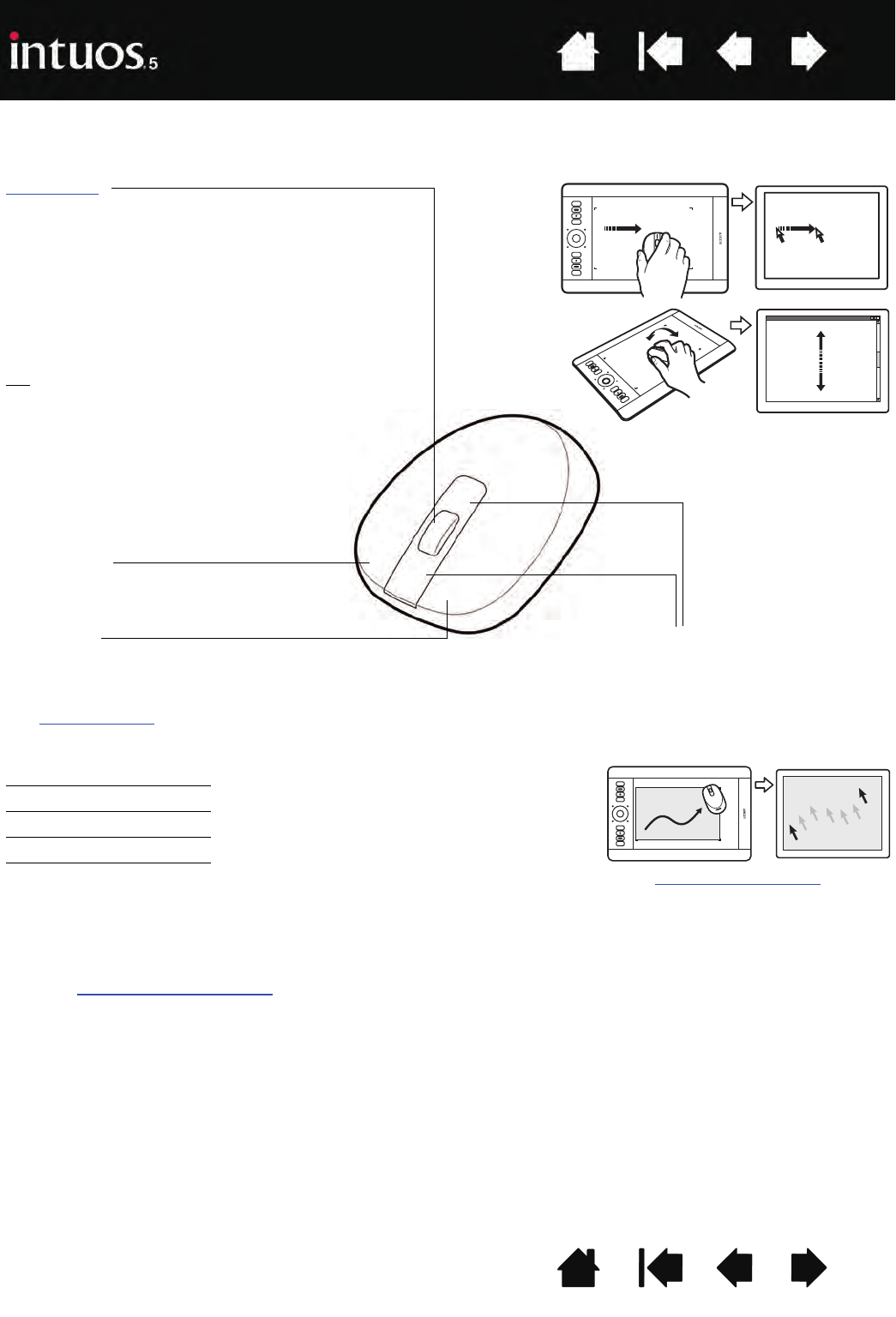
115
IndexContents
115
IndexContents
USING THE OPTIONAL INTUOS MOUSE
The optional Intuos Mouse is cordless, battery free, and works on the Intuos tablet.
Important: When the Intuos Mouse is not in use, place it on your desk. Leaving an Intuos tool on
the tablet may interfere with screen cursor positioning when using other pointing devices, or may
prevent your computer from going to sleep.
See also customizing the mouse.
Front and rear buttons
These are set for FORWARD and
BACK functionality within your
Internet browser.
Right button
Displays a context menu when pressed.
Left button
This is the primary button used to CLICK
and select.
The mouse buttons can be customized.
Default settings:
Left: CLICK
Right: RIGHT CLICK
Middle: MIDDLE CLICK
Front: FORWARD
Rear: BACK Mouse mode settings
Fingerwheel
Can be rolled, or pressed for an additional
button function.
• Roll the fingerwheel to scroll in most
windows and applications. Move the wheel
forward to scroll up, and back to scroll
down.
• Press down on the wheel to perform a
MIDDLE CLICK.
Tip: For Microsoft Office applications that
support a wheel mouse, press the CTRL
key and move the fingerwheel to zoom in
and out.
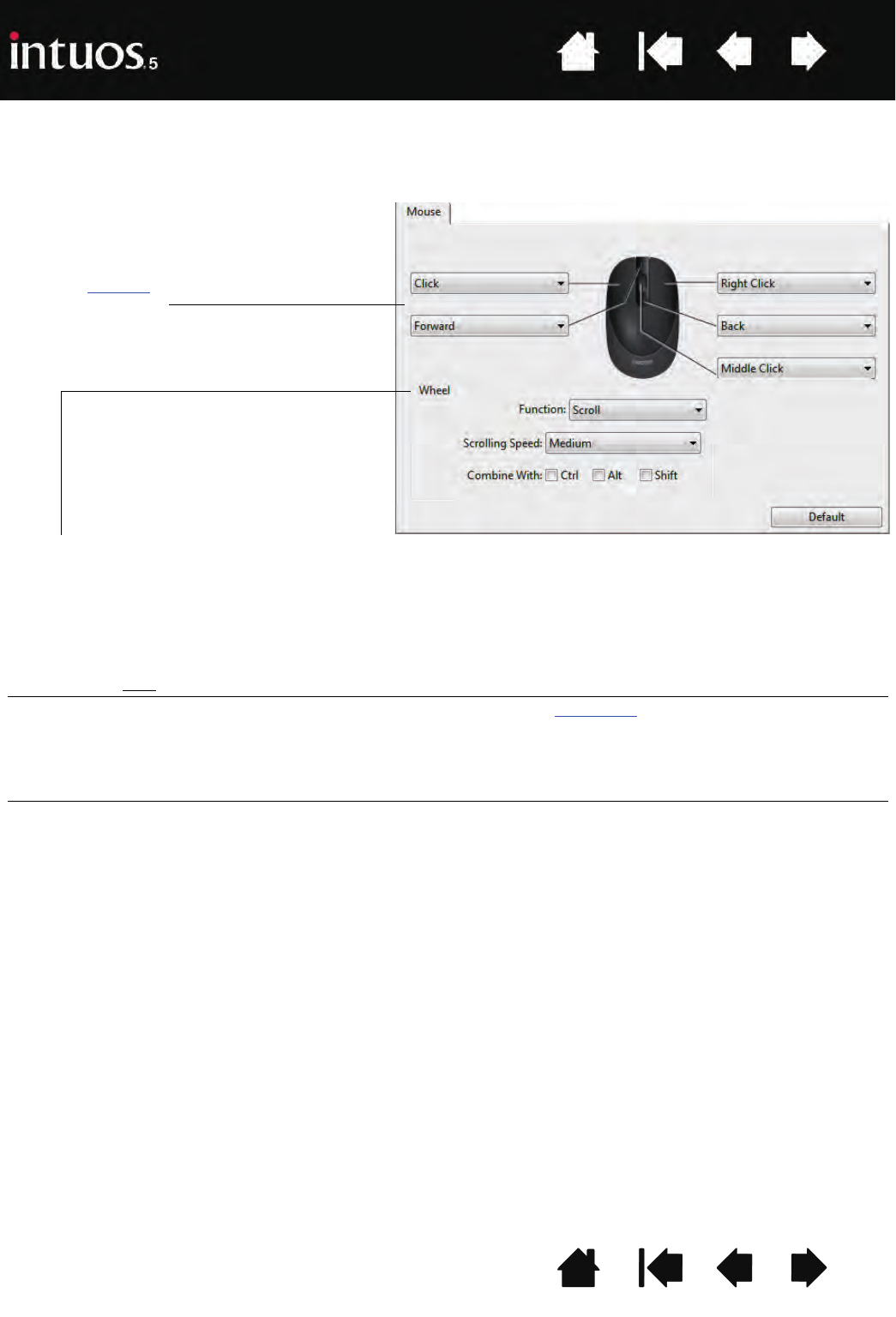
116
IndexContents
116
IndexContents
CUSTOMIZING THE MOUSE
Use the Intuos Mouse to open the Wacom Tablet control panel. The MOUSE tool will be selected in the TOOL
list. If the mouse is not automatically selected, choose it from TOOL list. Select the MOUSE tab.
The mouse buttons are chordable. You can press two or more buttons simultaneously. For example, if you
customize one button to simulate the CTRL key and another to simulate an ALT keystroke, when you press
both buttons a CTRL+ALT is simulated.
Note: To configure the Intuos Mouse for left-handed use, simply reassign the button functions as needed.
You can also open the Wacom Tablet control panel, click on OPTIONS... and select LEFT in the MOUSE
HANDEDNESS group.
Select the function to perform when
pressing a button.
WHEEL options control the fingerwheel function.
SCROLL Default setting. When selecting SCROLL, the tab displays custom scroll options. Choose a
SCROLLING SPEED to use for each notch of wheel movement.
When you select one or more COMBINE WITH: modifier key options, the selected option(s) will be
sent to the application along with each scroll action. For example, you can create custom zooming
or other actions within an application.
Mac: The available options are OPTION, COMMAND (Apple key), CONTROL, and SHIFT.
KEYSTROKE Assign custom functions to the fingerwheel by selecting KEYSTROKE. This is useful when working
with repetitive functions. Keystroke(s) that you define are sent once for each notch of wheel
movement.
To double the speed of a keystroke action, enter the keystroke sequence twice within the DEFINE
KEYSTROKE dialog box.
DISABLED Disables the wheel function.
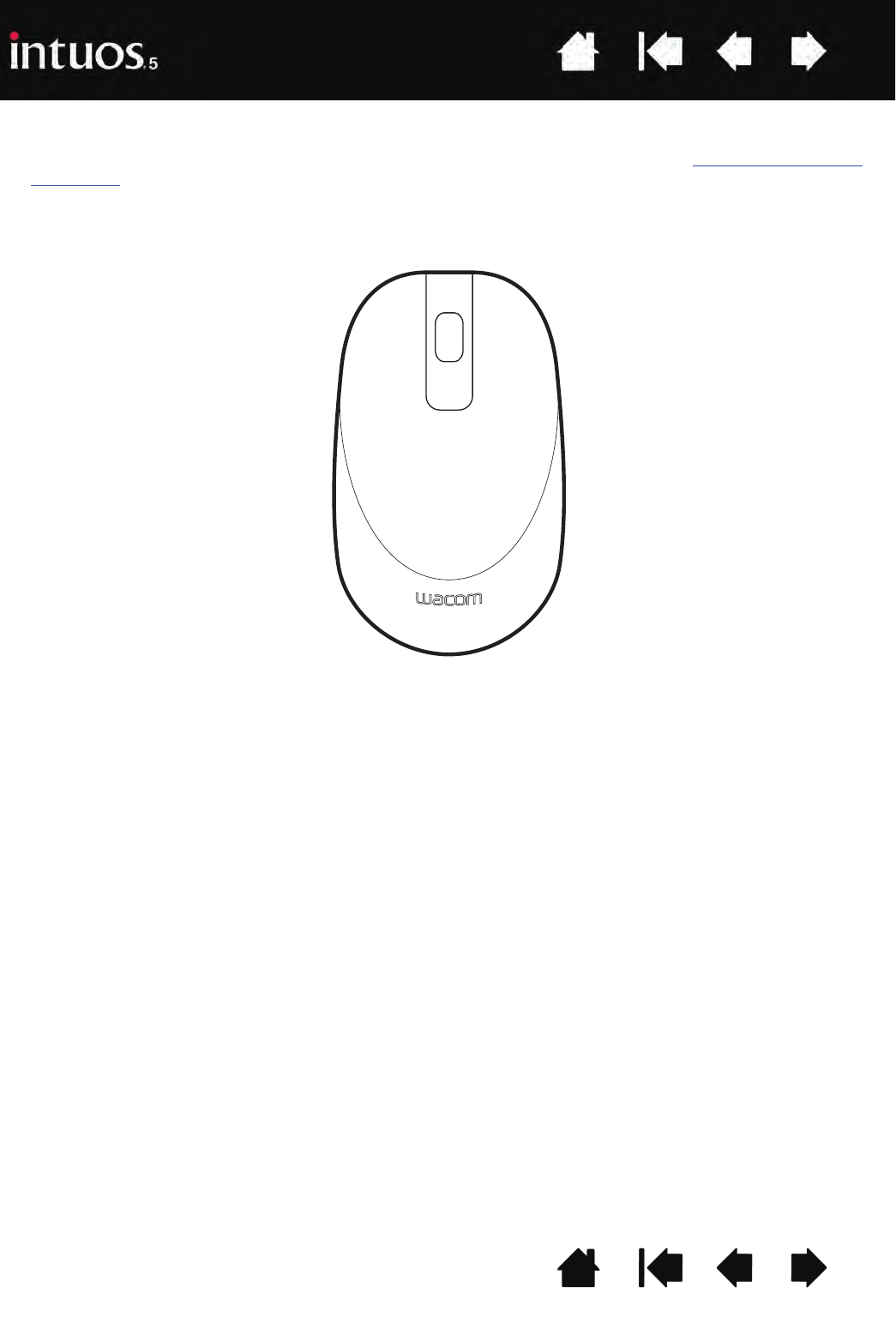
117
IndexContents
117
IndexContents
TES TI N G T HE MO US E
1. Use the Wacom Tablet control panel to open the DIAGNOSTICS dialog box. See testing controls and
input tools.
2. With the DIAGNOSTICS dialog box open, place the Intuos Mouse on the tablet active area and test by
clicking each mouse button. A tablet status LED should brighten and the SWITCHES state should
change for each button you click.
3. When the DIAGNOSTICS dialog box is first opened the WHEEL status should be 0. Move the fingerwheel
backward. The WHEEL status should change from 0 to +1.
4. Move the fingerwheel forward. The WHEEL status should change to -1.
When done, click CLOSE to exit the dialog box.
4
2
5
3
1
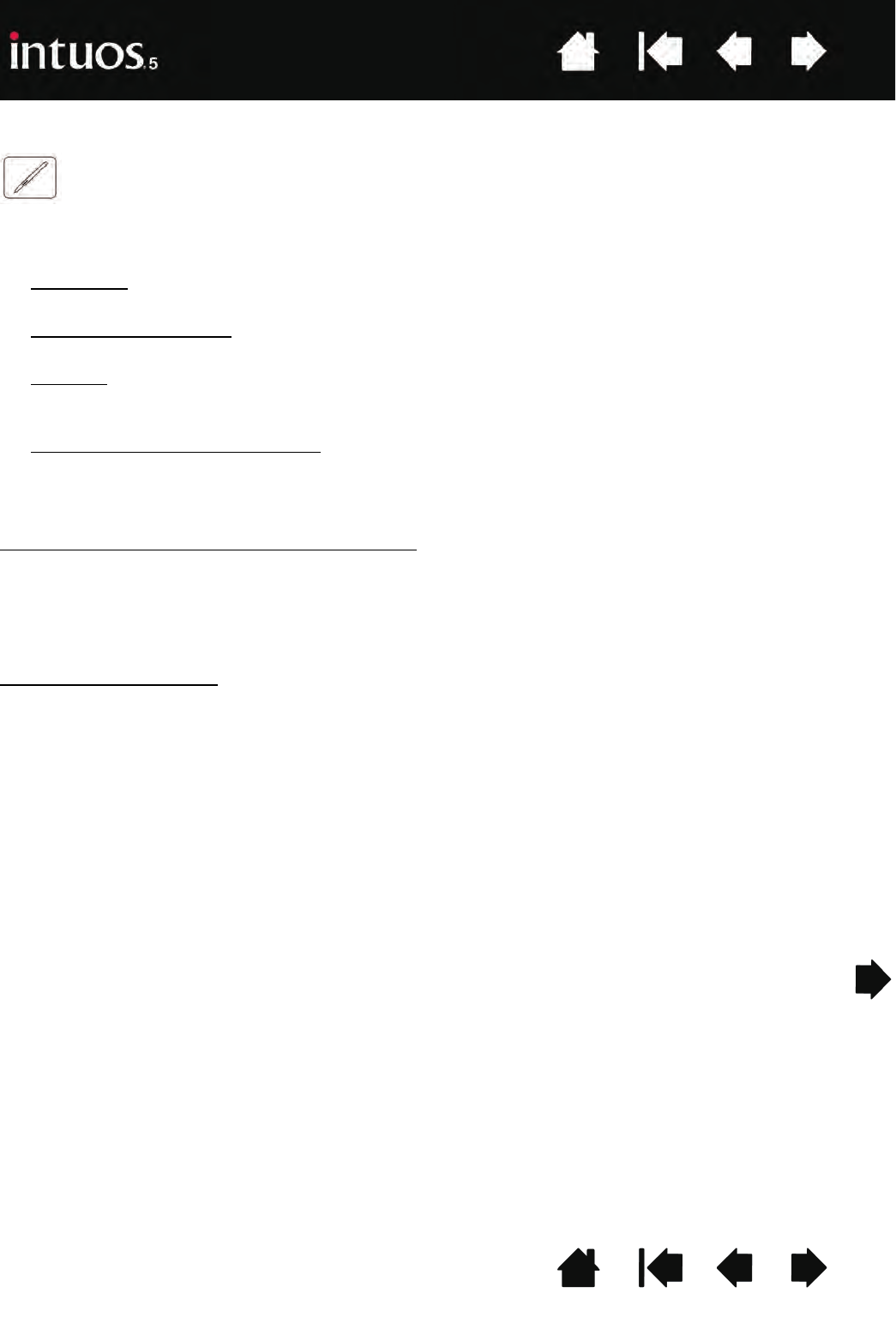
118
IndexContents
118
IndexContents
PEN AND DIGITAL INK CAPABILITIES IN WINDOWS
Microsoft Windows 7 and Vista provide extensive support for pen input. Pen features are supported in all
versions of Windows 7 and Vista except Windows 7 Starter and Home Basic, and Windows Vista Home
Basic. Use Intuos and your Wacom pen for quick, intuitive results.
•Note taking
. Jot notes and capture quick sketches in Windows Journal. Use the Journal search engine
to locate your handwritten content.
• Handwriting recognition. Quickly enter handwritten information anywhere the computer accepts typed
input. Convert your handwritten content to typed text at any time.
•Gestures
. Make simple gestural movements on the tablet to trigger customizable actions.
To customize gestures, select the FLICKS tab in the Windows 7 PEN AND TOUCH or Windows Vista PEN
AND INPUT DEVICES control panel.
• Digital Ink in Microsoft Office 2007. Utilize the enhanced digital mark-up and inking tools found on the
REVIEW tab within applicable applications.
The Windows 7 or Vista Input Panel enables you to use handwriting or an on-screen keyboard to directly
enter text with your Wacom pen.
There are different ways to launch the Input Panel:
• Click on the Input Panel icon which appears when you move the screen cursor into a text entry area.
• Click on the Input Panel tab, located by default on the left edge of the display screen.
• Click on the Tablet PC Input Panel icon located on the Windows Taskbar. If the icon is not visible, right-
click on the Taskbar, select TOOLBARS, and TABLET PC INPUT PANEL.
To disable the Input Panel:
1. Open the Tablet PC Input Panel.
2. Select TOOLS and OPTIONS.
3. Choose the OPENING tab and uncheck the following boxes:
•F
OR TABLET PEN INPUT, SHOW THE ICON NEXT TO THE TEXT BOX
•SHOW THE INPUT PANEL TAB.
4. Click OK.
For details, study the documentation that came with your system, including the Windows training tools and
Tablet PC tutorial. To access the Tablet PC Pen Training, from the START menu choose ALL PROGRAMS,
TABLET PC, and TABLET PC PEN TRAINING. Search the Windows help system for training tools if they are not
available from the START menu.
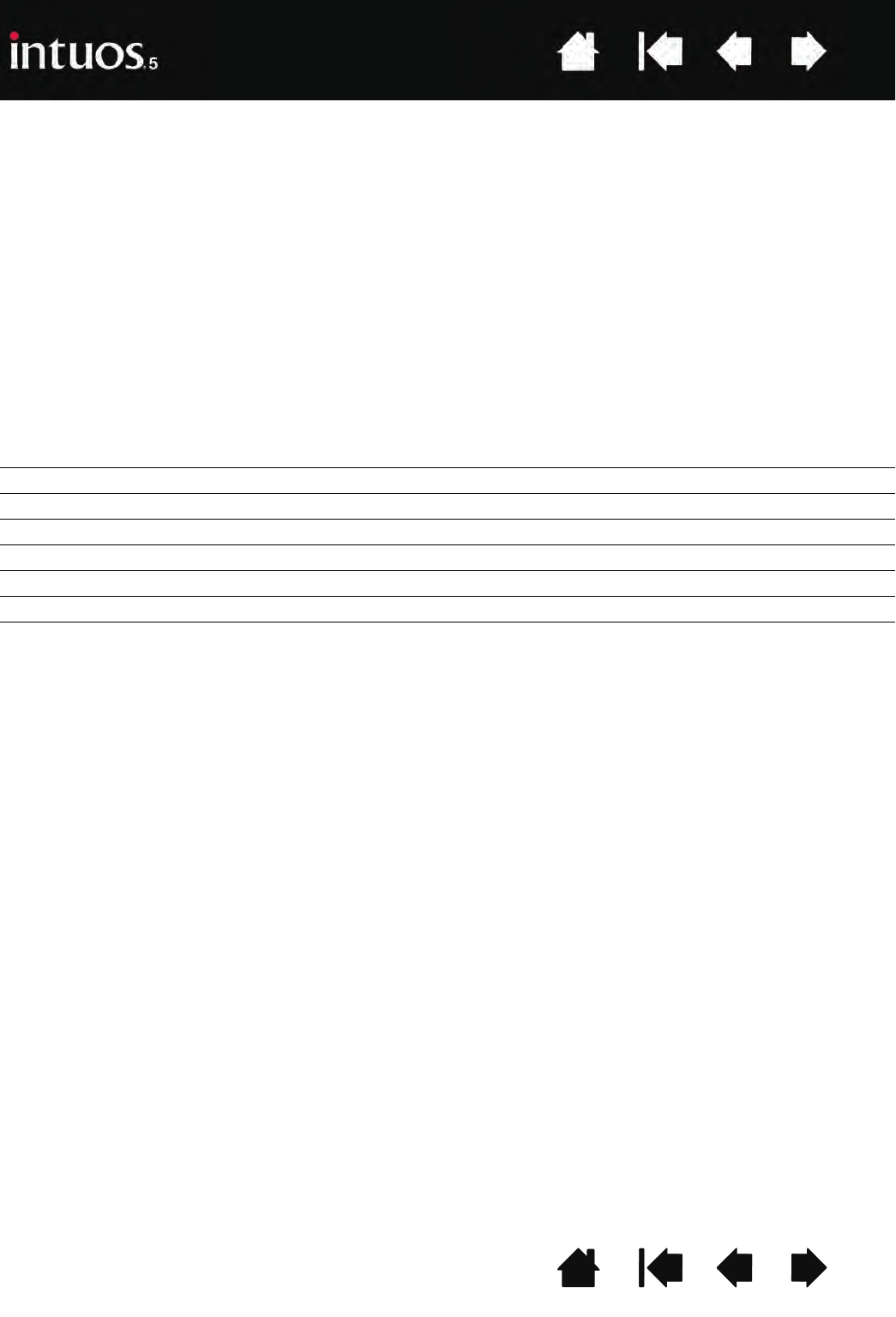
119
IndexContents
119
IndexContents
Search the Microsoft web site for enhanced information about digital inking in Windows. You can also visit
the Wacom web site at www.wacom.com/vista
Note: The following workarounds in the Wacom software driver improve performance in Windows 7 and
Vista:
• The Pen Flicks and ‘press-and-hold-to-right-click’ features are disabled in graphics applications
using the Wintab API.
•There is no pressure sensitivity in Journal and other Ink features when both the Flicks and ‘press-
and-hold-to-right-click’ features are disabled in the Windows 7 PEN AND TOUCH or Windows
Vista PEN AND INPUT DEVICES control panel.
PRODUCT INFORMATION
To learn more about Intuos, visit the Wacom web site for your region. You can also discover which
software applications are currently tablet enhanced to support the pressure sensitivity and other special
functionality of your tablet.
USA, Canada, Central and South America http://www.wacom.com/productinfo
Europe, Middle East and Africa http://www.wacom.eu
Japan http://tablet.wacom.co.jp
Asia Pacific (English) http://www.wacom.asia
China (Simplified Chinese) http://www.wacom.com.cn
Korea http://www.wacomkorea.com
Taiwan http://www.wacom.com.tw
Thailand http://www.wacom-thai.com
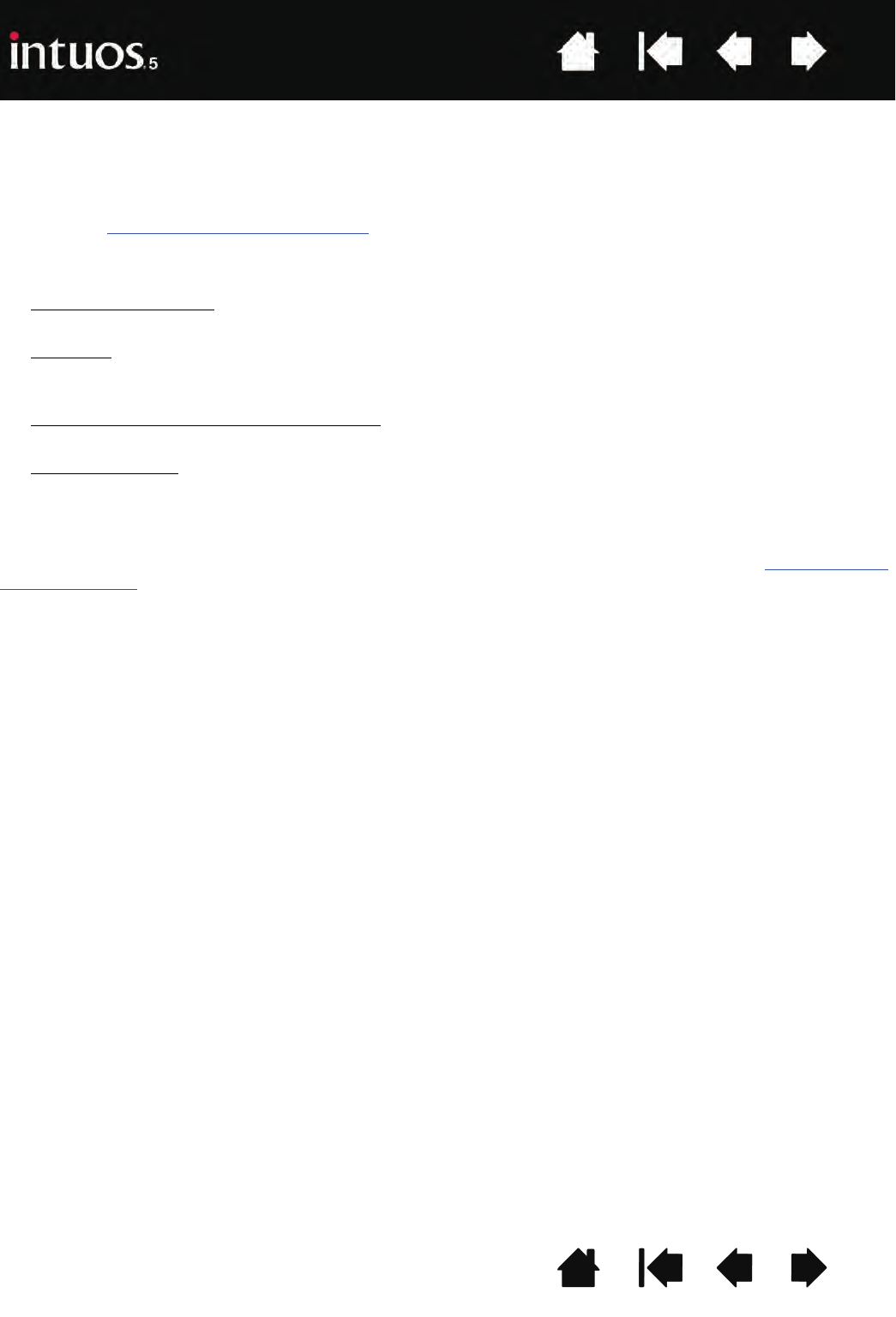
120
IndexContents
120
IndexContents
ORDERING PARTS AND ACCESSORIES
Your Intuos professional pen tablet is the ultimate master tool for creative professionals. The tablet,
combined with the Intuos Grip Pen and other available input tools, enables you to paint more intuitively,
illustrate better, and edit imagery faster than ever before.
To p u rc h a s e available parts and accessories, refer to the Wacom tablet Read Me file and see who to call for
your region.
You can also do the following:
• In the USA or Canada, call 1.888.884.1870 (toll-free) or visit Wacom’s web site at
http://www.WacomDirect.com (USA only).
• In Europe, call +49 (0)180.500.03.75 or send an email to spareparts@wacom.eu. Or, visit
http://shop.wacom.eu. You can also contact your local dealer, distributor, or technical support using
the appropriate number for your region.
• In Australia, Singapore, Taiwan and Korea, please visit: www.BuyWacom.com.au,
www.BuyWacom.com.sg, www.BuyWacom.com.tw and www.BuyWacom.co.kr, respectively.
• In other countries, please contact your local dealer or distributor.
Some parts and accessories may not be available in all regions.
AVAILABLE PARTS AND ACCESSORIES
For a list of available parts and accessories, visit the Wacom web site for your region. See ordering parts
and accessories.
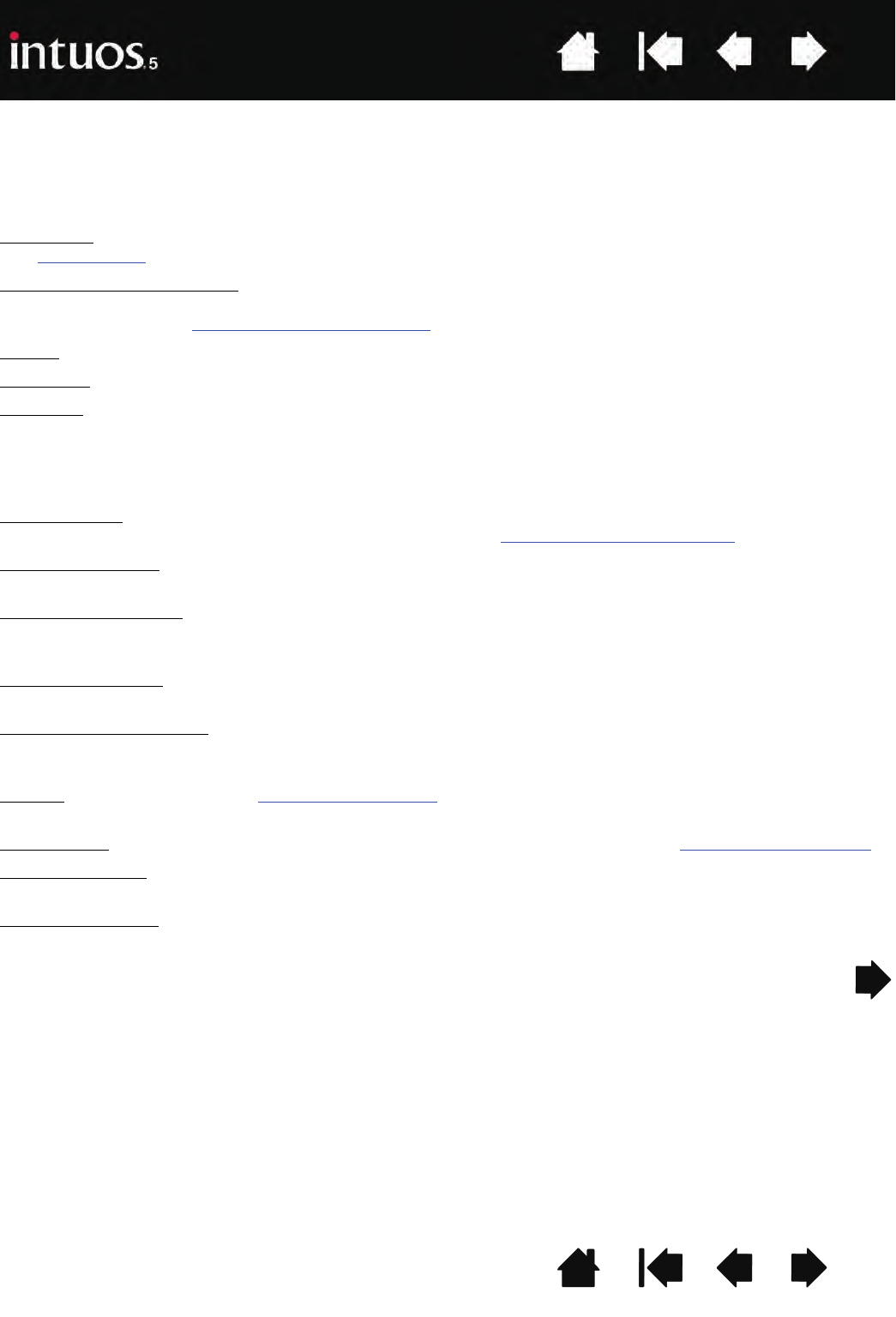
121
121
IndexContents
IndexContents
GLOSSARY
Active area. The navigation and drawing area of the tablet where touch or your Intuos tools are detected.
See touch sensor.
Application-specific settings. Intuos tool and tablet settings that have been customized for individual
applications. The Wacom Tablet control panel enables you to customize a tool to behave uniquely in
different applications. Application-specific settings are in effect whenever you use the application.
Aspect. The ratio between the vertical and horizontal dimension of the tablet or display.
Click force. The amount of force you must apply to the pen tip for a click to occur.
Digital Ink. A broad category that typically describes handwritten content which has been created using
pen-based input on a computer. This handwritten content takes the form of sketches, ink mark-up, or
handwriting. The handwriting can optionally be converted to typewritten text or simply left alone for use in
its original format. Depending on your system and applications settings, the handwritten text you make
with digital ink can be converted on-the-fly or at another time.
Display Toggle. An Intuos feature that allows you to work with your tablet on all displays or on one display
at a time. Available only on multiple monitor systems. See working with Display Toggle.
Double-click assist. A function of the Wacom Tablet control panel that makes it easier to double-click by
setting the size of the double-click distance.
Double-click distance. The maximum distance (in screen pixels) that the screen cursor can move between
clicks and still be accepted as a double-click. Increasing the double-click distance makes double-clicking
easier, but may cause a delay in brush strokes in some graphics applications.
Double-click speed. The maximum time that can pass between clicks and still be accepted as a
double-click.
Eraser-aware application. A software application that has built-in support for the pen eraser.
These applications take advantage of the eraser in different ways, depending on what makes sense for the
application.
Expand. A motion used when navigating with touch. Touch the tablet with two fingers spaced closely
together. Then while still touching the tablet surface, move your fingers apart.
ExpressKeys. The customizable control keys located on your Intuos tablet. See using the ExpressKeys.
ExpressKeys Left. A tablet setting where the Touch Ring and ExpressKeys are oriented to the left of the
tablet.
ExpressKeys Right. A tablet setting where the Touch Ring and ExpressKeys are oriented to the right of the
tablet.
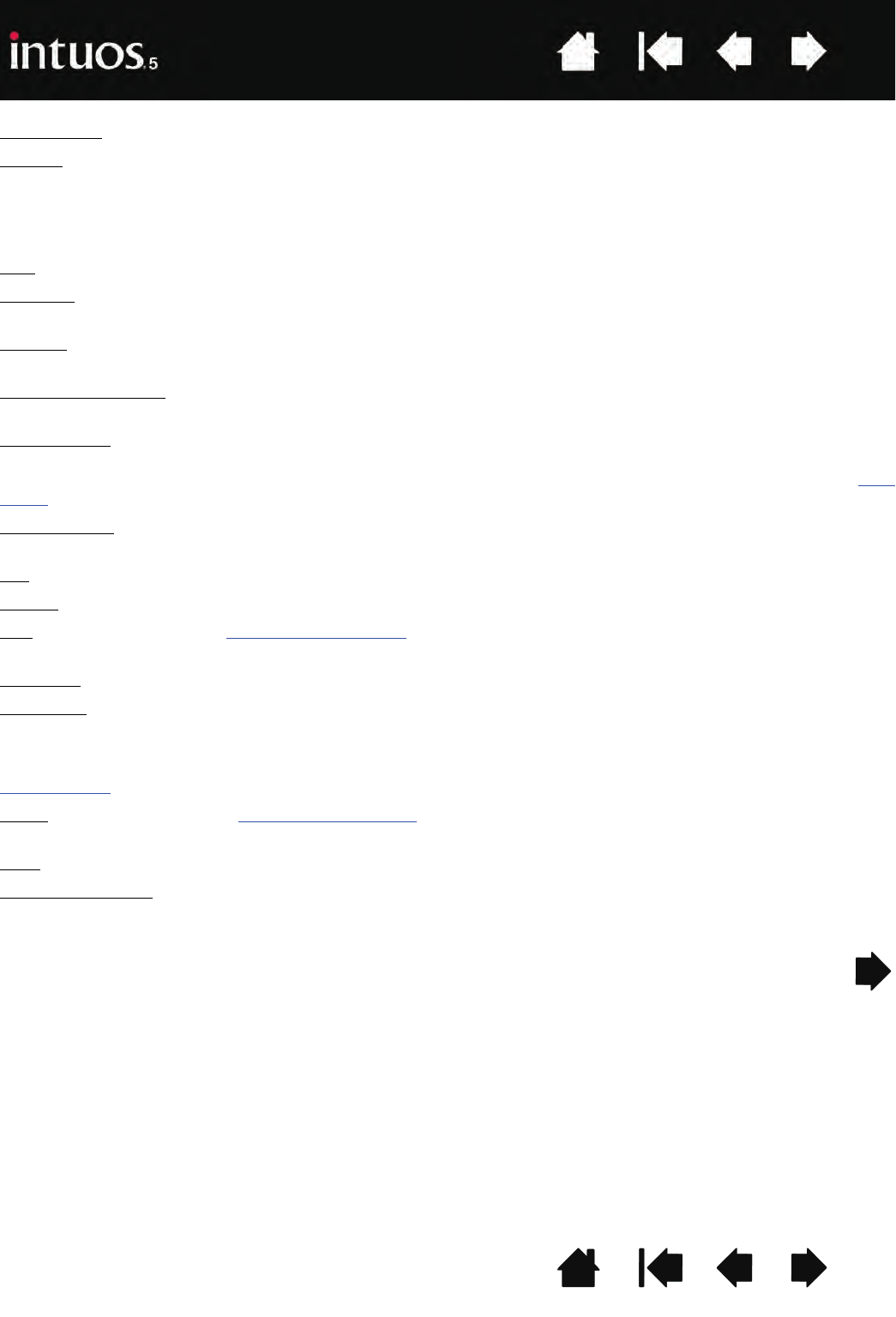
122
IndexContents
122
IndexContents
Fingerwheel. The control wheel on the optional Intuos Mouse and Airbrush.
Journal. A Microsoft Windows application that electronically simulates a physical journal pad, but with the
advantages of digital note taking. For example, you can create quick sketches and jot handwritten notes
that can be converted to text and sent on to colleagues for digital mark-up. Journal includes a variety of
pen, marker, and highlighter tools, plus an eraser that is easily activated by the eraser end of your Wacom
pen. Additionally, your handwritten content is searchable within Journal.
LED. Light-Emitting Diode. Used as tablet indicator light(s).
Mapping. The relationship between the tool position on your Intuos tablet and the cursor position on the
monitor screen.
Modifier. Modifier keys include SHIFT, ALT, and CTRL for Windows, or SHIFT, CONTROL, COMMAND, and OPTION
for Mac. You can customize your Intuos tool buttons or ExpressKeys to simulate a modifier key.
Mouse acceleration. A setting that allows you to adjust the screen cursor acceleration when using mouse
mode.
Mouse mode. A method for positioning the screen cursor. When you place an Intuos tool on the tablet,
you can move the screen cursor with a “pick up and slide” motion similar to using a traditional mouse.
This is known as relative positioning, and is the default setting for the optional Intuos Mouse. See also pen
mode.
Mouse speed. A setting that allows you to adjust the speed at which your screen cursor moves when using
mouse mode.
Nib. The replaceable pen tip.
Pairing. A method of creating a virtual cable link between two devices.
Pan. A motion used when navigating with touch. Touch the tablet surface with your fingers and move
them in the same direction.
Pen input. A method of controlling a computer using the pen tool on your Intuos tablet.
Pen mode. A pen input method of positioning the screen cursor. Wherever you place your Intuos pen tool
on the tablet, the screen cursor will jump to the corresponding point on the screen. This is known as
absolute positioning, and is the default setting for Intuos pen tools. Pen mode allows you to quickly
position the screen cursor without having to first find it and then move it across the desktop. See also
mouse mode.
Pinch. A motion used when navigating with touch. Touch the tablet with two fingers spaced slightly apart.
Then while still touching the tablet surface, move or ‘pinch’ your fingers together.
Pixel. The smallest unit of measure on your monitor screen.
Pressure sensitive. A quality of the Wacom pen tip and eraser that senses the amount of pressure being
applied. This is used to create natural-looking pen, brush, and eraser strokes in applications that are
pressure sensitive.
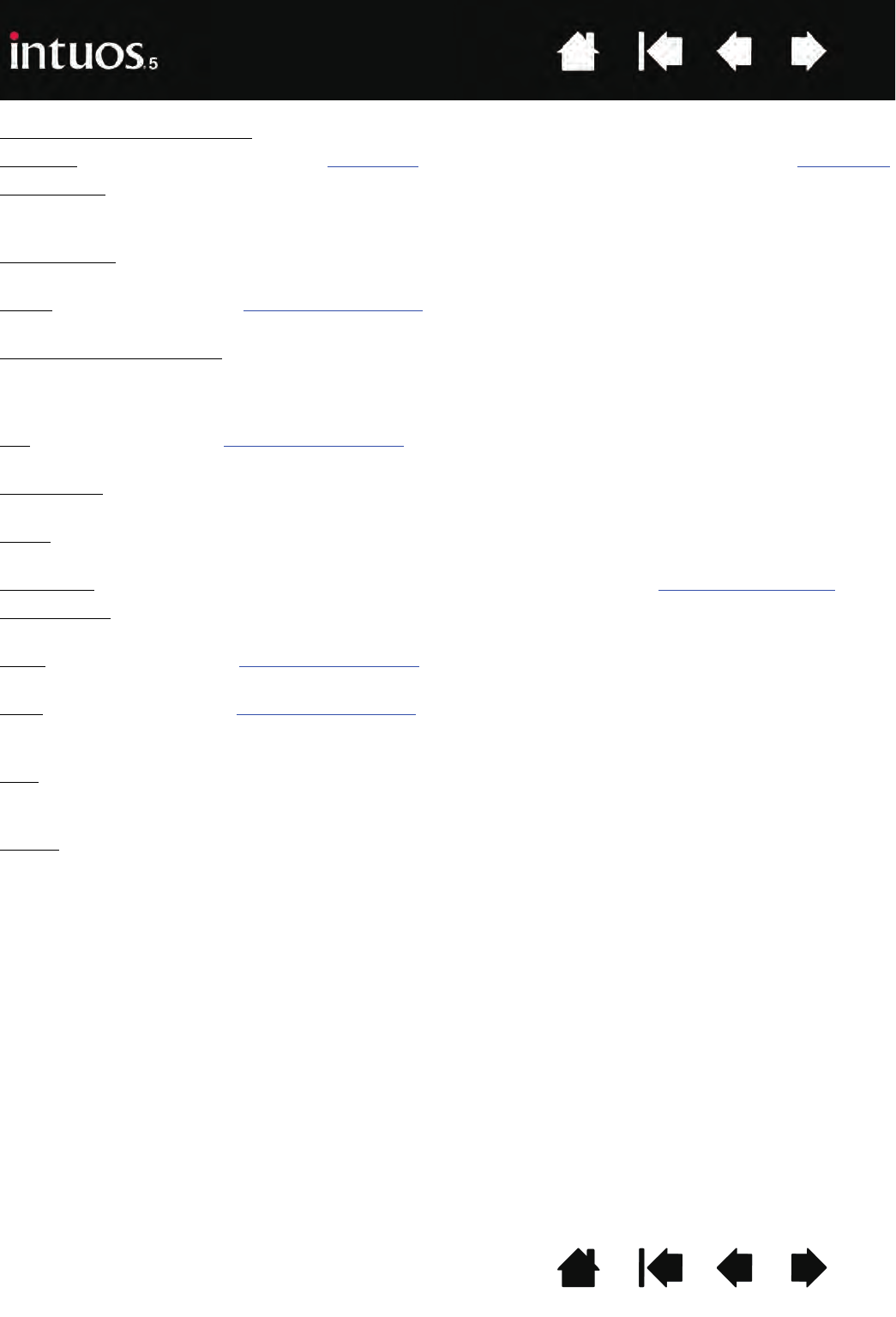
123
IndexContents
123
IndexContents
Pressure-sensitive application. Any application that supports pressure-sensitive input.
Proximity. The height above the tablet active area where input tool detection occurs. See also positioning.
Radial Menu. A hierarchical menu (in radial format). Each level of the menu consists of eight menu slices
which may contain various features and options to choose from. You can customize the buttons of your
input tools or tablet to display this menu.
Screen cursor. The pointer on the display screen. Screen cursors come in different shapes (such as an
I-beam, arrow, or box), depending on which application you are running.
Swipe. A motion used when navigating with touch. Touch the tablet surface with three, four, or five fingers
and move them in the same direction.
Tablet PC Input Panel (TIP). The Microsoft Windows Tablet PC Input Panel enables you to use your Wacom
pen to create handwritten notes or work with an on-screen keyboard. The Input Panel dynamically
converts your handwriting to text. Information you create can then be inserted into other documents,
spreadsheets, or illustrations.
Ta p . A motion used when navigating with touch. Touch and lift a single finger (or multiple fingers,
depending on the gesture) from the tablet.
Tilt sensitive. A quality of the pen tip and eraser that senses the amount of tilt between the tool and tablet.
This is used to create natural-looking pen, brush, and eraser strokes in applications that are tilt sensitive.
To u c h . A method of interacting with a computer using only your fingers on the Intuos tablet. May also be
referred to as “touch input”.
Touch Ring. The customizable control ring located on your Intuos tablet. See using the Touch Ring.
Touch sensor. The navigation area of your Intuos tablet where touch is detected. The touch sensor resides
within the active area, and does not accept pen input.
Track. A motion used when navigating with touch. Touch and move a single finger across the tablet
surface.
Tw i s t . A motion used when navigating with touch. Touch the tablet with two fingers spaced slightly apart
and move (rotate) them in a circular fashion, or move them in opposing directions. Alternatively, hold one
finger stationary and track your other finger around the stationary finger.
USB. Universal Serial Bus. A hardware interface standard for connecting computer peripheral devices.
USB ports support hot-plugging, which allows you to disconnect a USB device without turning off your
computer.
Wintab. An interface standard used by Windows applications for receiving tablet information.
Intuos supports all Wintab-compatible applications under Windows.

124
IndexContents
124
IndexContents
INDEX
About the manual 5
Accessories and parts
available 120
ordering 120
Active area, understanding 16
Adding a new tool 72
Airbrush
holding 114
replacing the tip 107
using 114
Applications, using integrated 112
Application-specific settings 69
changing 71
creating 70
removing 71
Art Pen, using 114
Button functions 59
Care, for tools and tablet 106
Clicking, how to 22
Control panel
basics 18
features 46
lists 47
manage settings 45
opening 45
tabs 47
Controls, testing 91
Customizing 44
double-click 49
eraser feel 50
advanced 50
ExpressKeys 53
mouse
buttons 116
fingerwheel 116
pen 48
Radial Menu 66
tablet 52
ExpressKeys 53
Touch Ring 54
tablet to screen mapping 55
tilt sensitivity 52
tip feel 49
advanced 50
tool buttons 51
touch
custom functions 41
standard functions 41
Touch Ring 54
Diagnostics 91
Display Toggle, working with 67
Double-click, customizing 49
Double-clicking, how to 22
Dragging, with pen 22
Drawing
with pressure sensitivity 24
with tilt 24
Driver downloads, obtaining 105
Environmental conditions 106
Eraser feel
advanced 50
customizing 50
Erasing 25
Ergonomics 12
Expert settings, importing 113
Express View display 109
ExpressKeys
customizing 53
testing 92
using 27

125
IndexContents
125
IndexContents
Eye-hand coordination exercise 25
Features
control panel 46
pen 11
pen & touch models 7
pen models 9
pen stand 11
Force proportions 55
Functions, button 59
General problems, troubleshooting 94
Holding
Airbrush 114
pen 20
Information, product 119
Input tools, testing 91
Installing multiple tablets 111
Intuos
about your tablet 6
setting up 12
tablets matrix 6
the touch experience 30
using 19
Mac-specific problems, troubleshooting 102
Manual, about 5
Mapping, to multiple monitors 18
Mouse
buttons, customizing 116
fingerwheel
customizing 116
using 115
testing 117
using 115
Mouse mode 56
Multiple
monitors
mapping to 18
working with 18
tablets, installing 111
Navigation, customizing for touch 40
New tool, adding 72
Nib, replacing 107
Options, advanced 74
Ordering parts and accessories 120
Orientation, configuring for tablet 14
Parts and accessories
available 120
ordering 120
Pen
clicking with 22
customizing 48
double-clicking with 22
dragging with 22
drawing
with pressure sensitivity 24
with tilt 24
erasing with 25
features 11
holding 20
pointing with 21
positioning with 21
replacing the tip 107
side switch 23
testing 93
tip, replacing 107
using 19
Pen mode 55
Pen problems, troubleshooting 95
Pen stand, using 20
Pens, optional 48
Pointing, with pen 21
Positioning, with pen 21
Preferences, managing tablet 110
Pressure sensitivity, drawing with 24
Product information 119
Proximity 21
Radial Menu
customizing 66
using 66
Removing application-specific settings 71
Screen area, portion of 57
Settings
application specific 69
changing application specific 71
creating application specific 70
removing application specific 71
Set-up 12

126
IndexContents
126
IndexContents
Side switch, using 23
Software
driver downloads 105
uninstalling 108
Ta b l e t
area, portion of 58
customizing 52
ExpressKeys
customizing 53
testing 92
using 27
features matrix 6
mode options, changing 73
orientation, configuring 14
pen & touch model features 7
pen model features 9
preferences, managing 110
storing 106
testing 89
Touch Ring
customizing 54
testing 92
using 29
working with 26
Tablet to screen mapping, customizing 55
Technical Support, contacting 104
Te s t i n g
controls 91
ExpressKeys 92
input tools 91
mouse 117
pen 93
tablets 89
tools 91
touch 43
Touch Ring 92
Tilt
drawing with 24
sensitivity, customizing 52
Tip feel
advanced 50
customizing 49
Tool buttons, customizing 51
Tools
testing 91
working with multiple 72
Tou ch
adjusting touch speed 40
basic actions 31
custom touch functions 41
customizing 39
disabling 42
five-finger gestures 39
four-finger gestures 37
gestures 31
navigating with 31
one-finger actions 32
options 31
setting navigation features 40
speed, adjusting 40
standard touch functions 41
testing touch 43
the experience 30
three-finger gestures 36
two-finger actions 33
two-finger gestures 33
Touch problems, troubleshooting 98
Touch Ring
customizing 54
testing 92
using 29
Troubleshooting
general problems 94
Mac-specific problems 102
pen problems 95
tables 94
testing controls 91
testing input tools 91
touch problems 98
Windows-specific problems 101
wireless connection problems 99
Uninstalling software 108
USB cable, connection 15

127
IndexContents
127
IndexContents
Using
Airbrush 114
applications integrated for tablet control 112
Art Pen 114
ExpressKeys 27
mouse 115
pen 19
Radial Menu 66
touch 30
Touch Ring 29
Wacom international offices 128
Windows-specific problems, troubleshooting 101
Wireless operation 75
battery
charging 80
life 83
management 80
replacement 84
components 75
connection problems 99
establishing a connection 77
optimizing the connection 79
power management 80
power saving 82
setup 76
status
battery 81
connection 81
testing the wireless connection 87
wireless module, removal from tablet 85
wireless receiver, storage in tablet 86
Work area, setting up 12
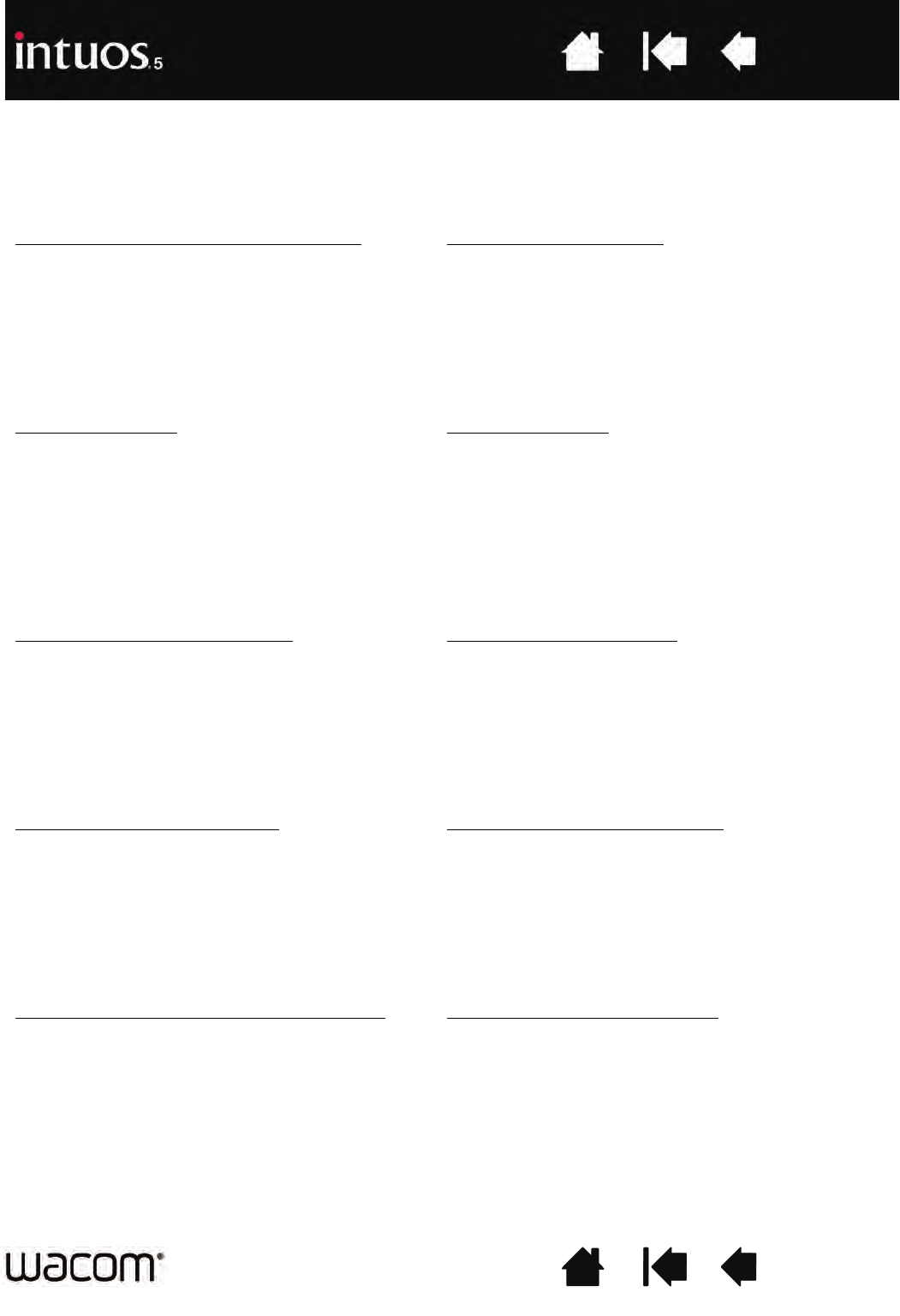
128
IndexContents
128
IndexContents
WACOM INTERNATIONAL OFFICES
WACOM TECHNOLOGY CORPORATION WACOM EUROPE GMBH
1311 SE Cardinal Court Europark Fichtenhain A9
Vancouver, WA 98683 47807 Krefeld
U.S.A. Germany
Telephone: +1.360.896.9833 Internet: http://www.wacom.eu
Fax: +1.360.896.9724
WACOM CO., LTD.
JAPAN TABLET SALES DIVISION
WACOM CO., LTD.
ASIA PACIFIC DIVISION
Harmony Tower 18F, 1-32-2 Hon-Cho, Harmony Tower 18F, 1-32-2 Hon-Cho,
Nakano-Ku, Tokyo 164-0012 Nakano-Ku, Tokyo 164-0012
Japan Japan
Internet: http://tablet.wacom.co.jp Telephone: +81.3.5309.1513
Fax: +81.3.5309.1514
WACOM CHINA CORPORATION WACOM KOREA CO., LTD.
1103, Beijing IFC West Tower #1211, 12F KGIT Sangam Center,
No. 8 Jianguomenwai Street 1601 Sangam-dong, Mapo-gu, Seoul 121-913, Korea
Chaoyang District, Beijing 100022 Telephone: +82.2.557.3894
China Fax: +82.2.557.3895
Internet: http://www.wacom.com.cn
WACOM AUSTRALIA PTY. LTD. WACOM SINGAPORE PTE. LTD.
Unit 8, Stage 1 Cumberland Green 5 Temasek Boulevard
2-8 South Street Rydalmere #12-09 Suntec Tower Five
NSW 2116 Australia Singapore 038985
Telephone: +61.2.9422.6700 Telephone: +65.6258.8640
Fax: +61.2.9420.2272 Fax: +65.6258.8697
WACOM TAIWAN INFORMATION CO., LTD. WACOM HONG KONG LIMITED
Suite 605, 6th floor, No. 205 Tun-Hwa North Road Room 1201, Tai Tung Building
Taipei, 105 Taiwan 8 Fleming Road
Telephone: +886.2.2712.2675 Wanchai, Hong Kong
Fax: +886.2.2712.9789 Telephone: +852.25739322
Fax: +852.25739500